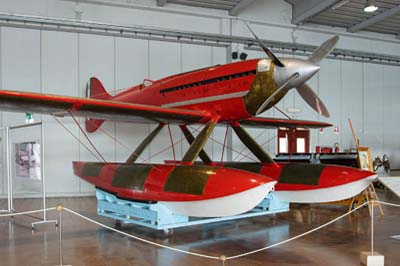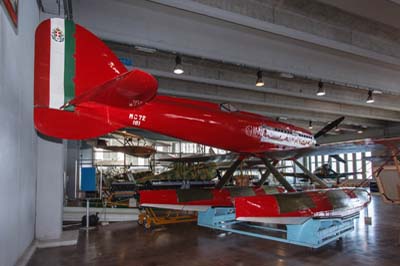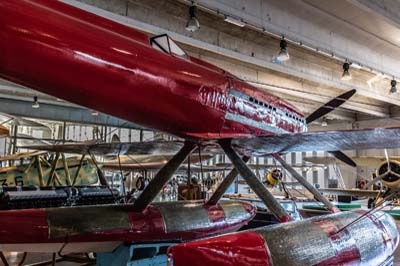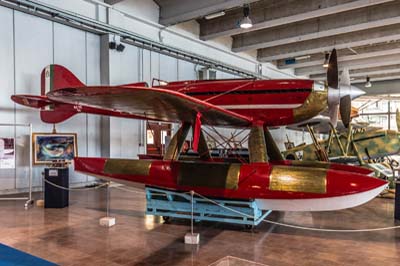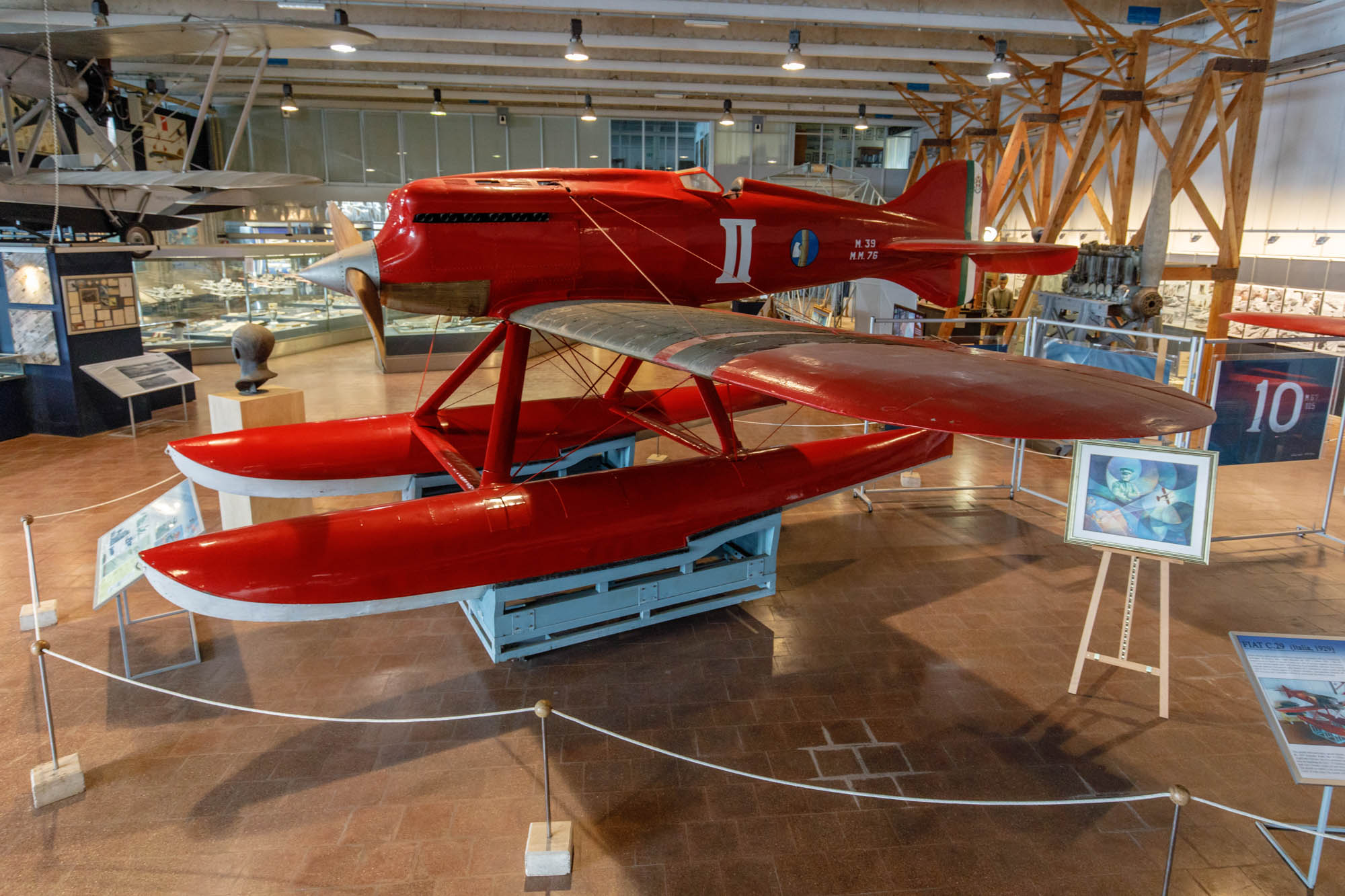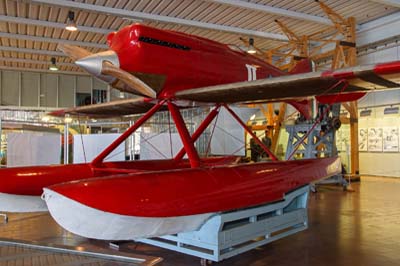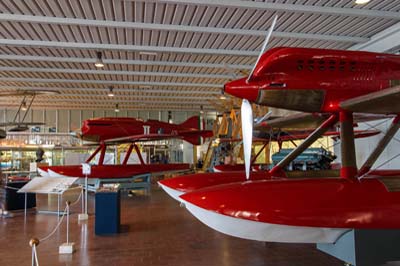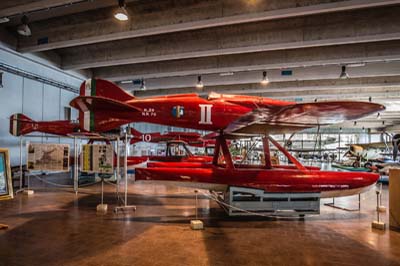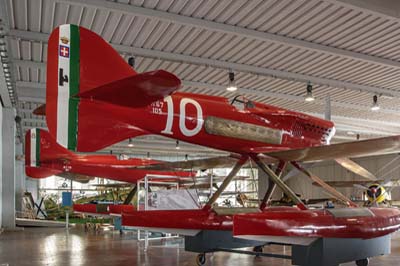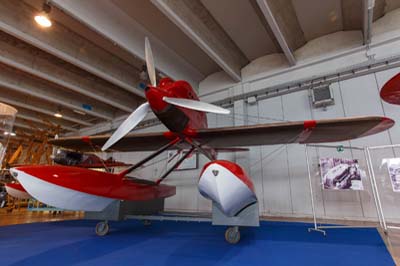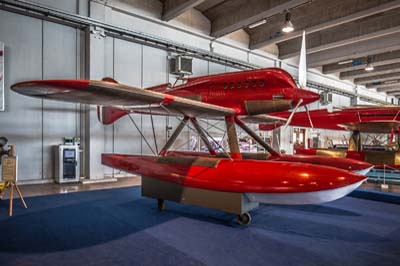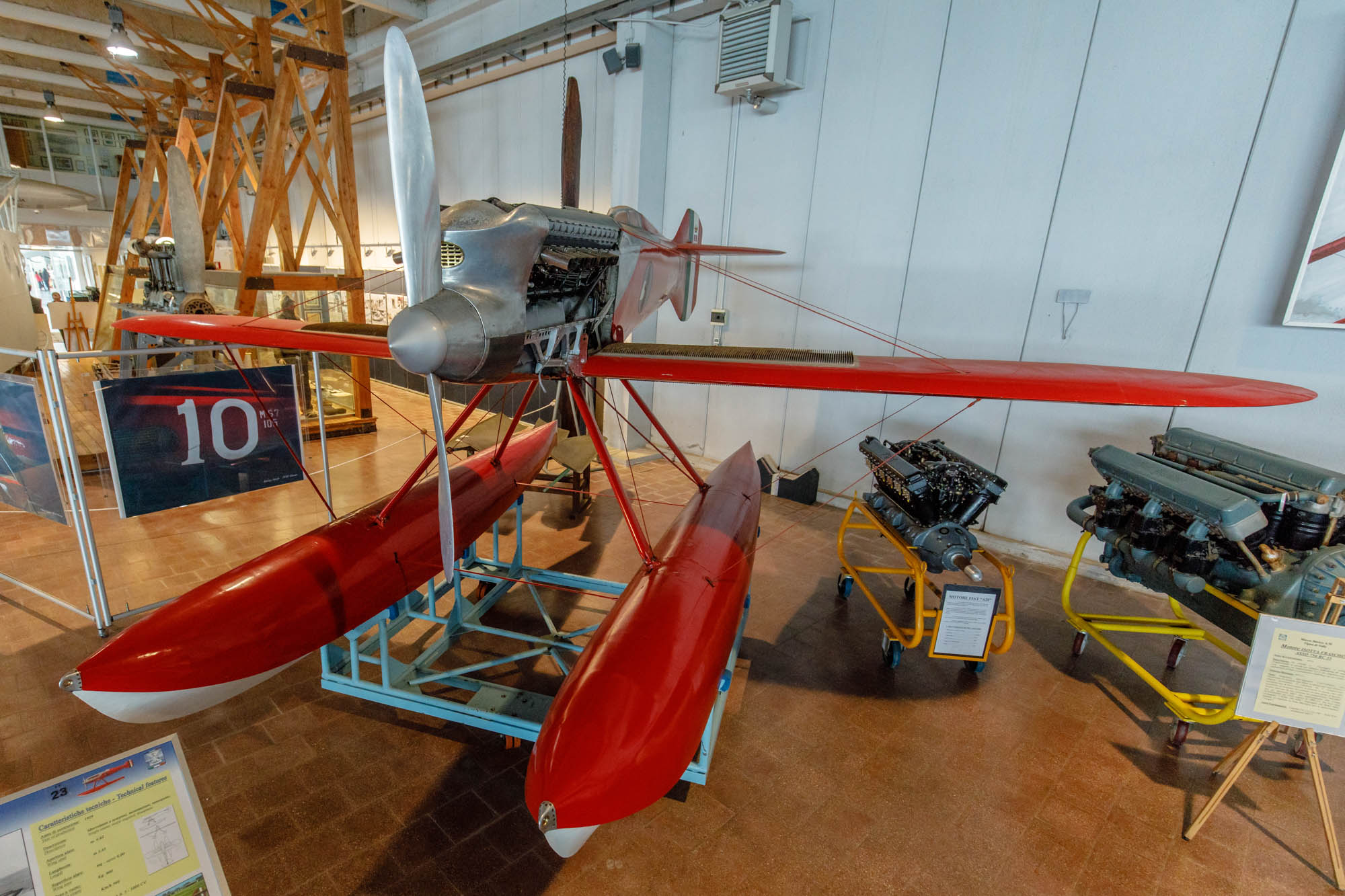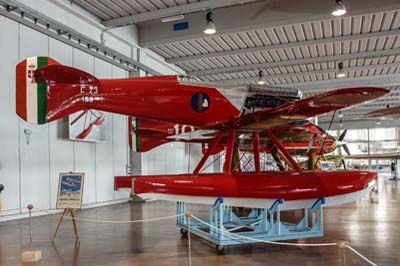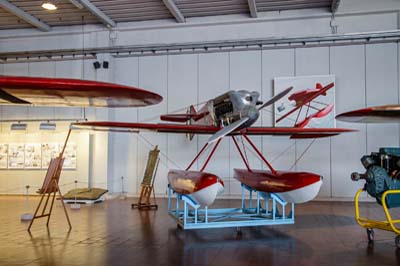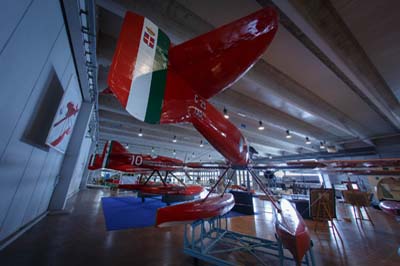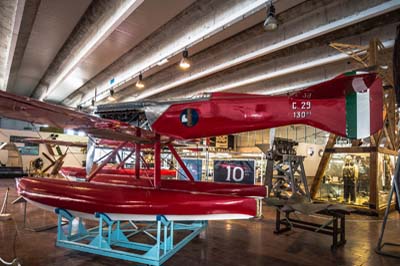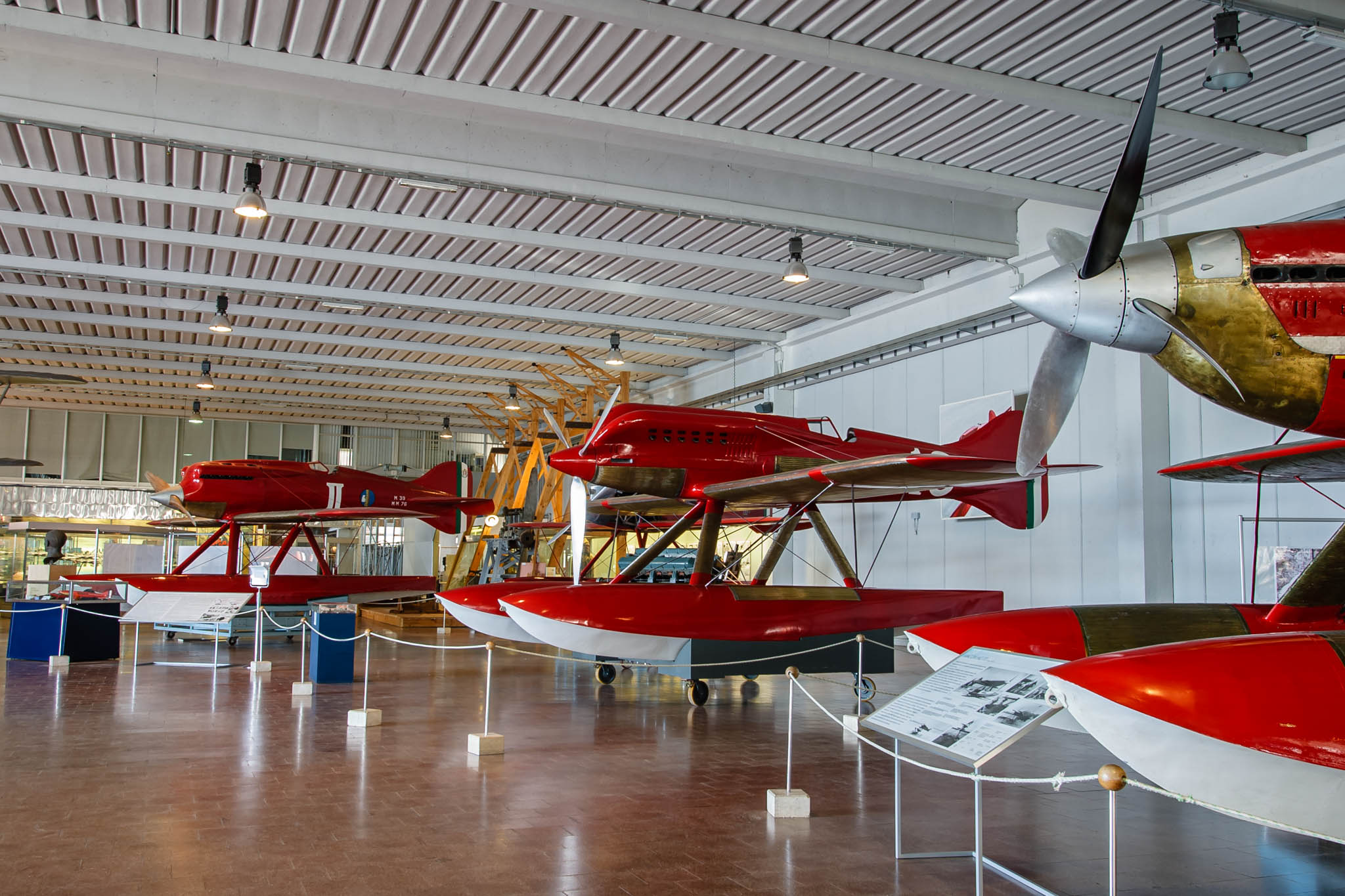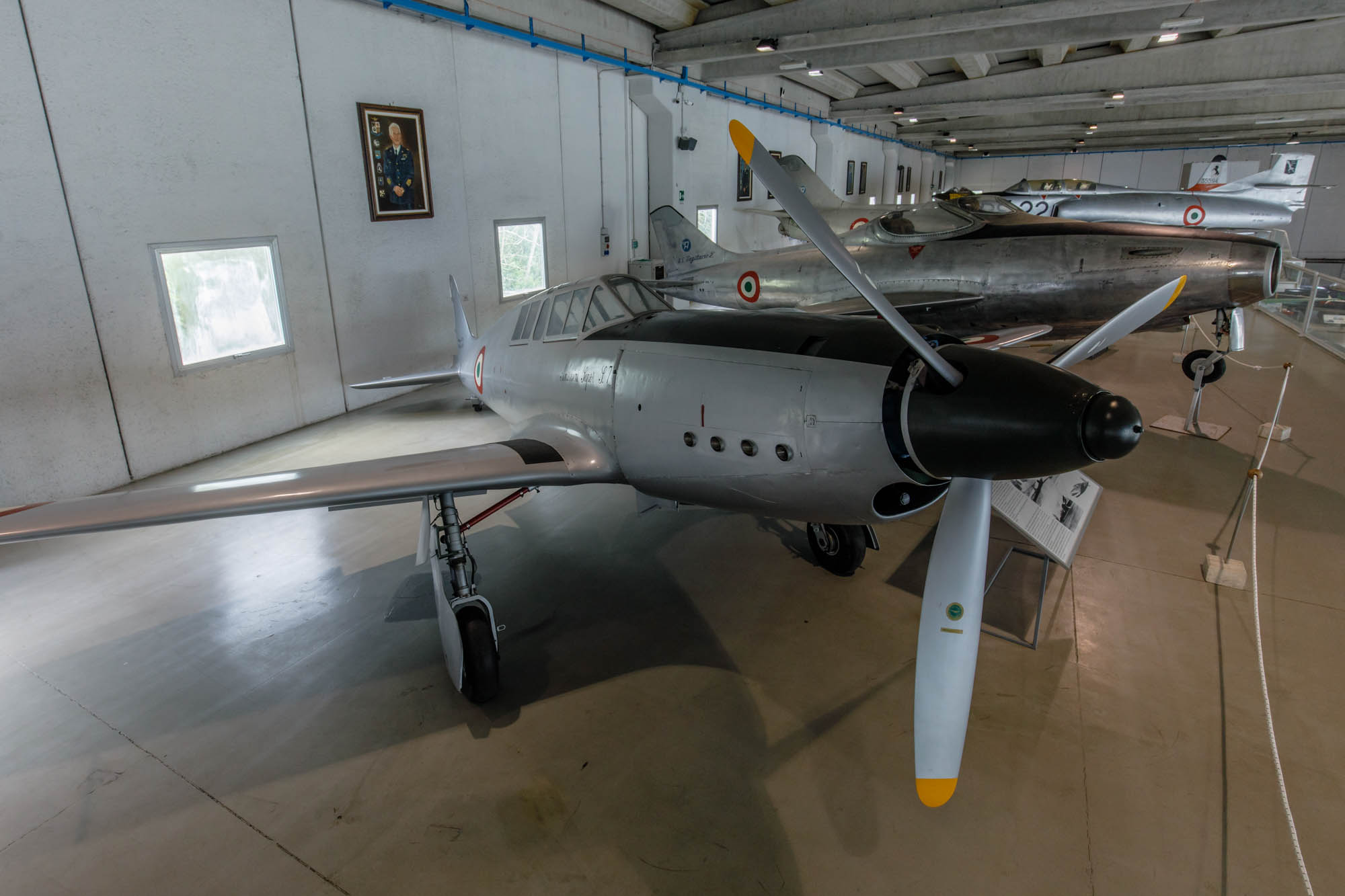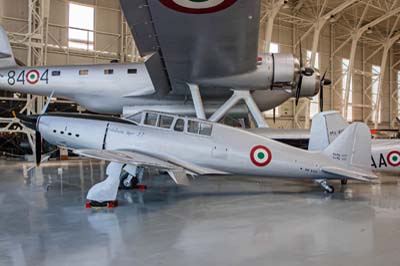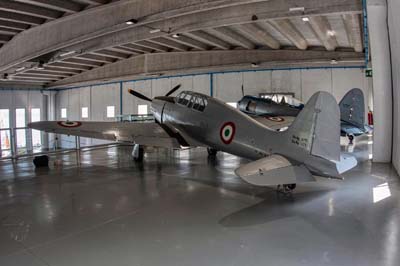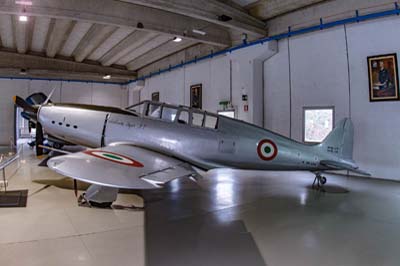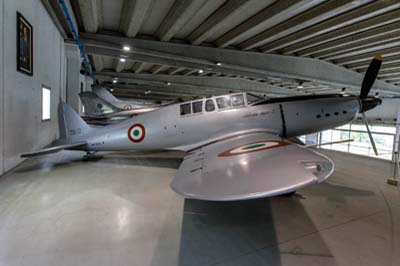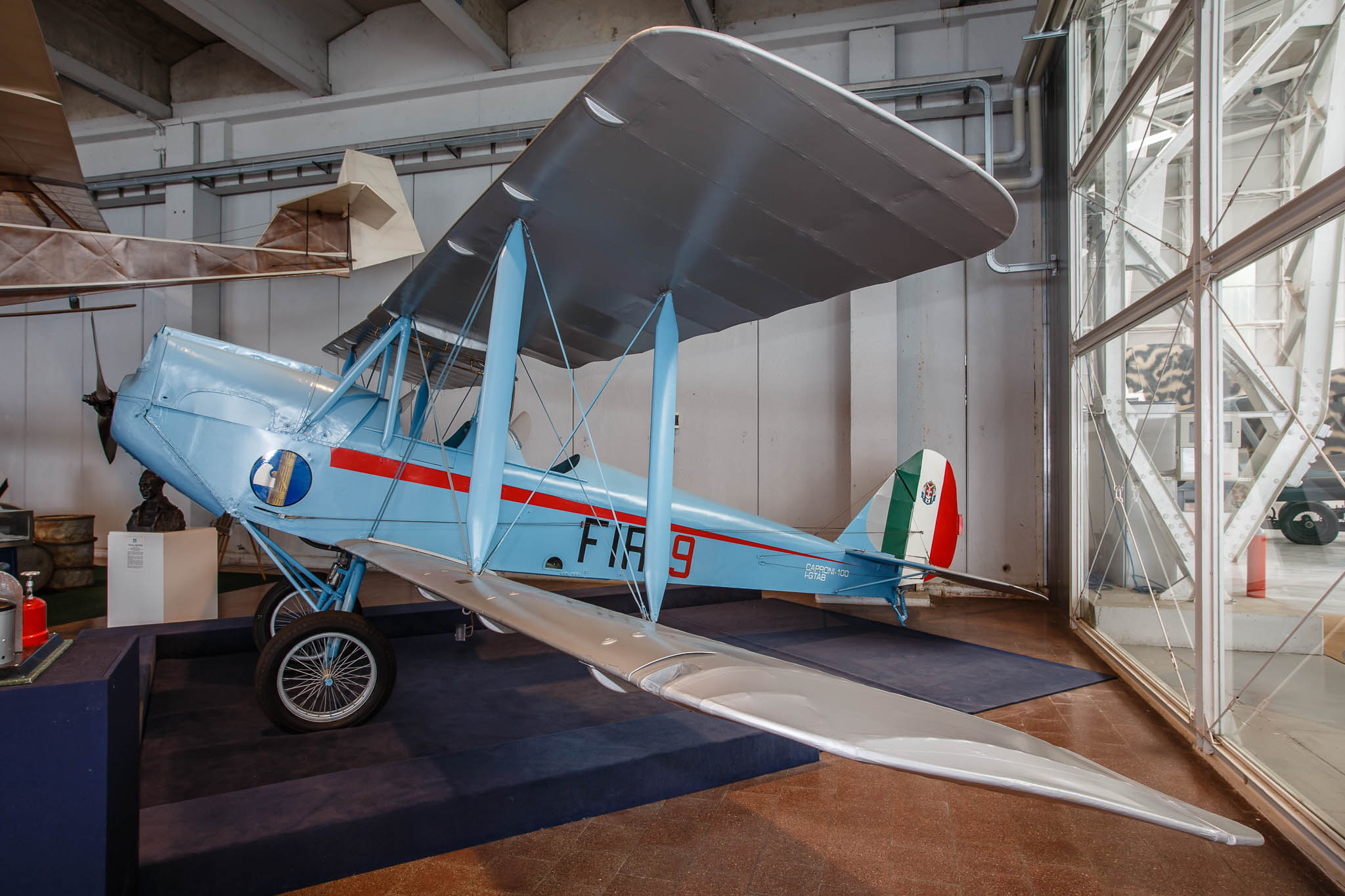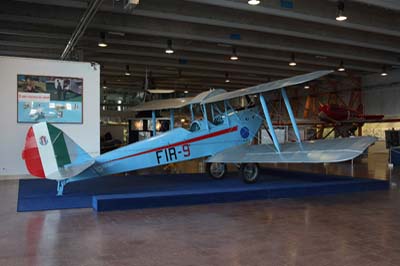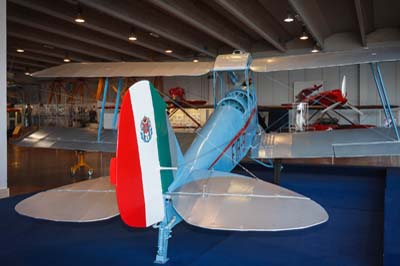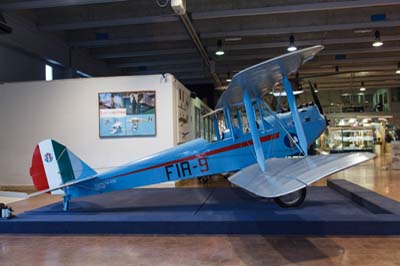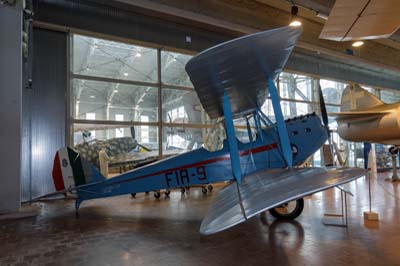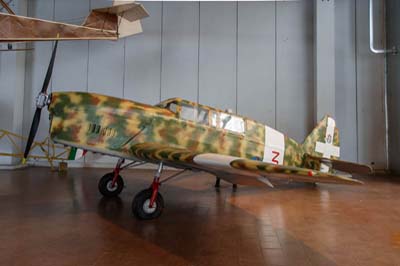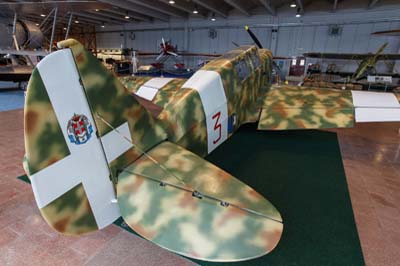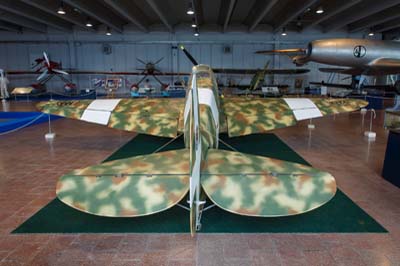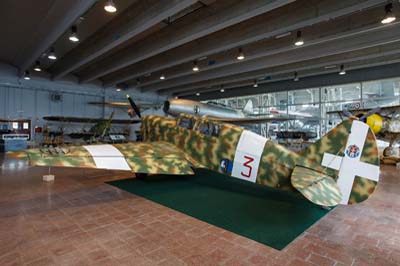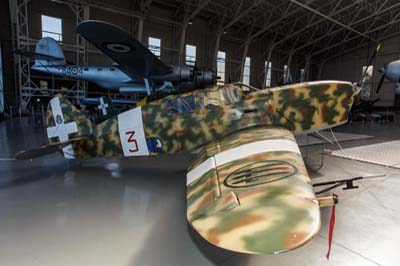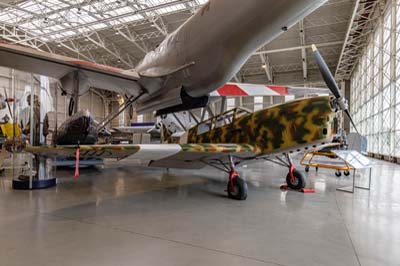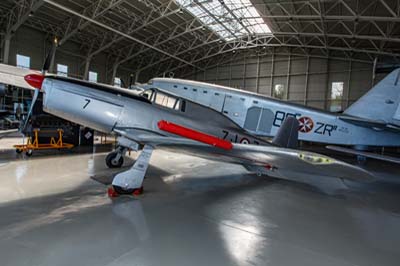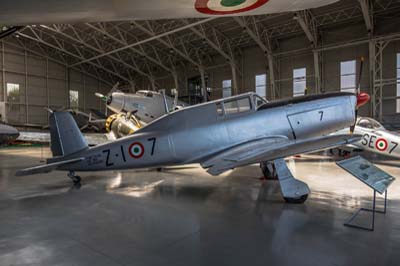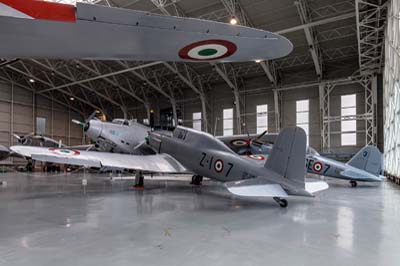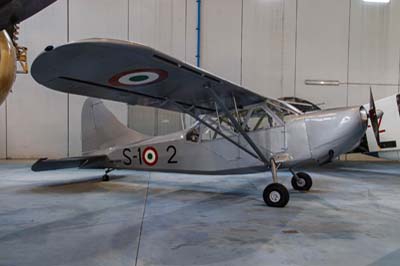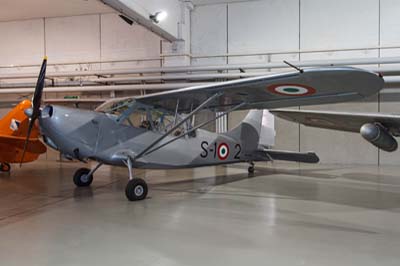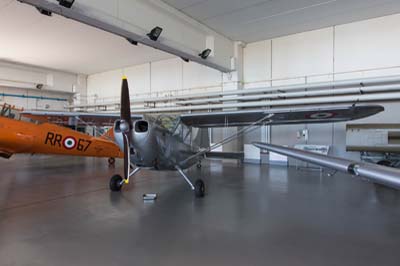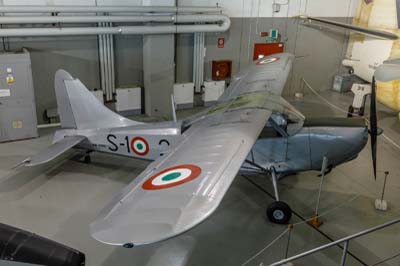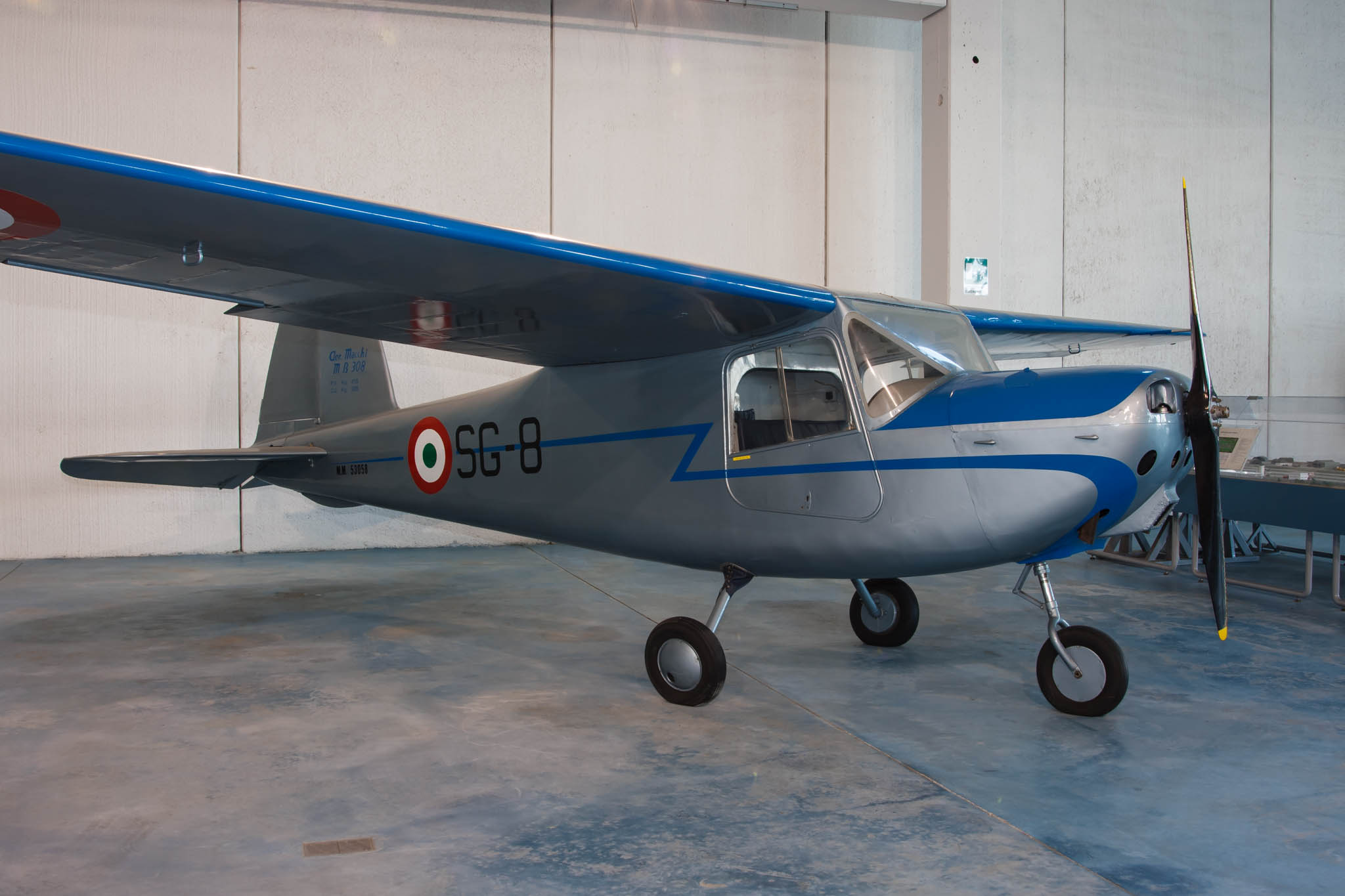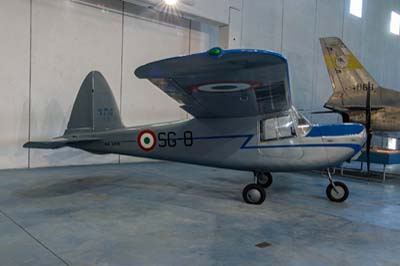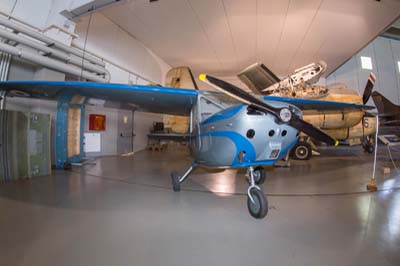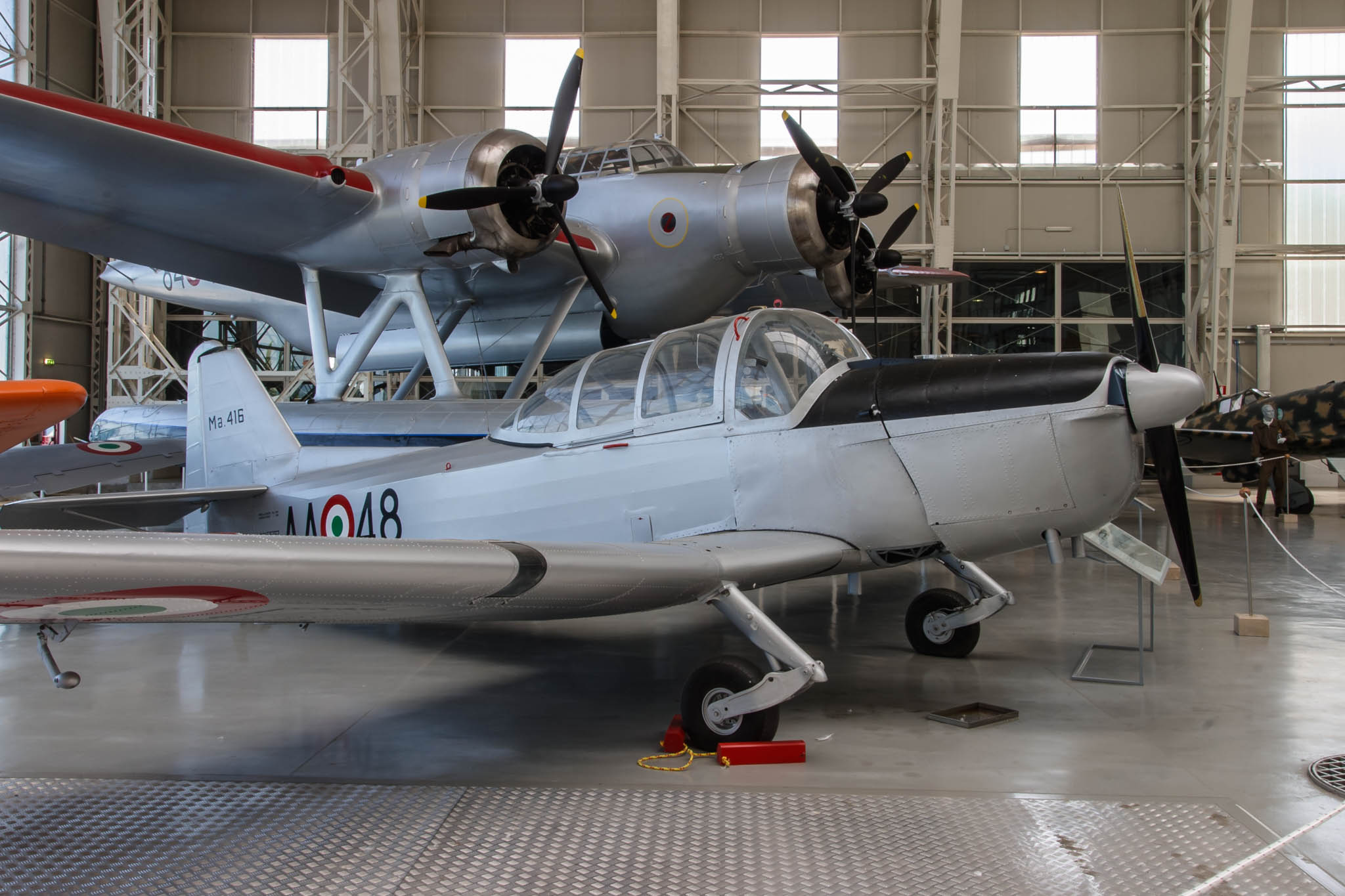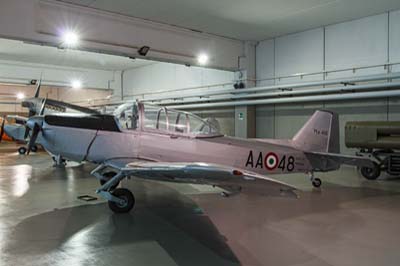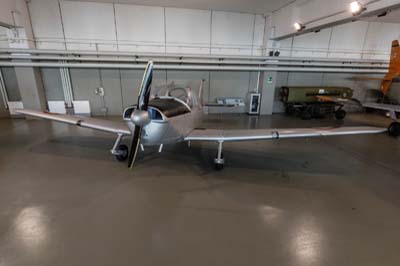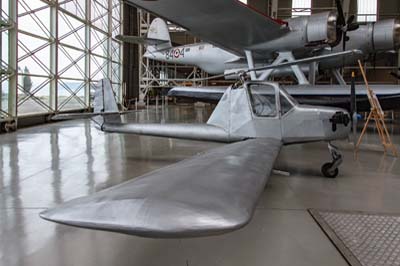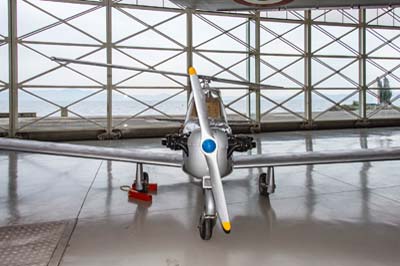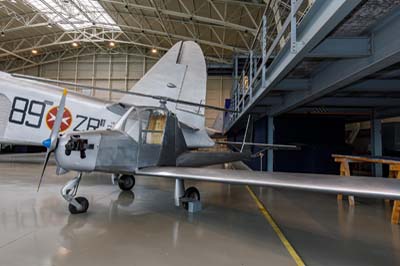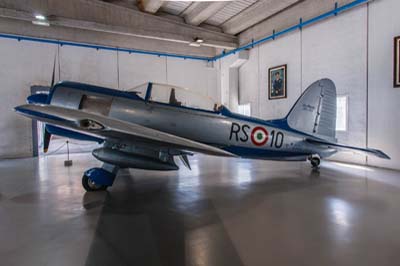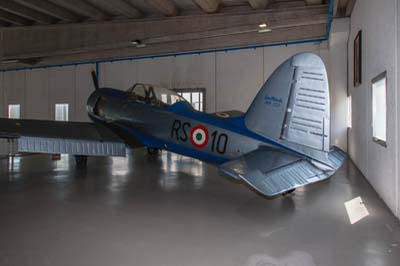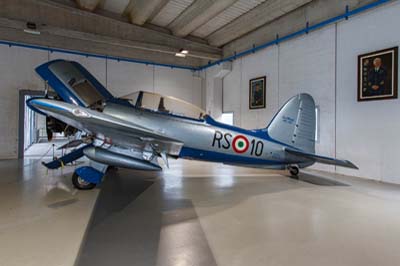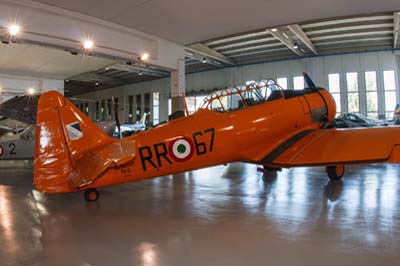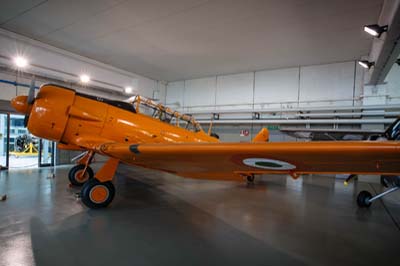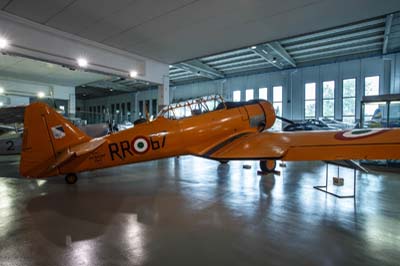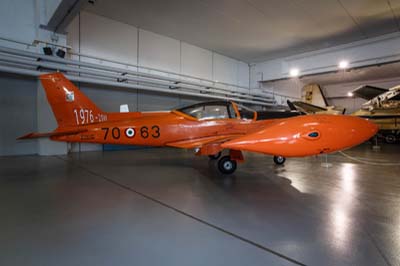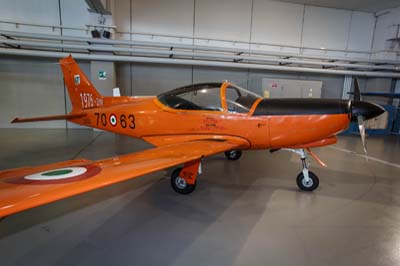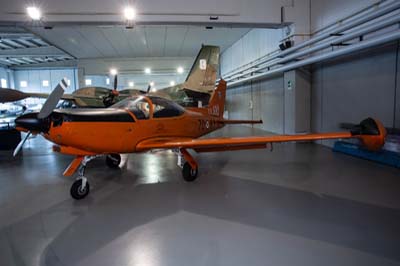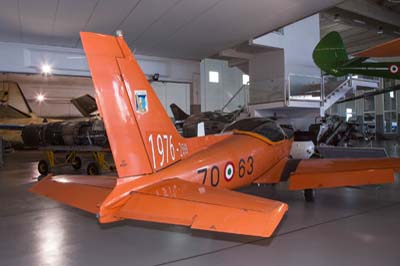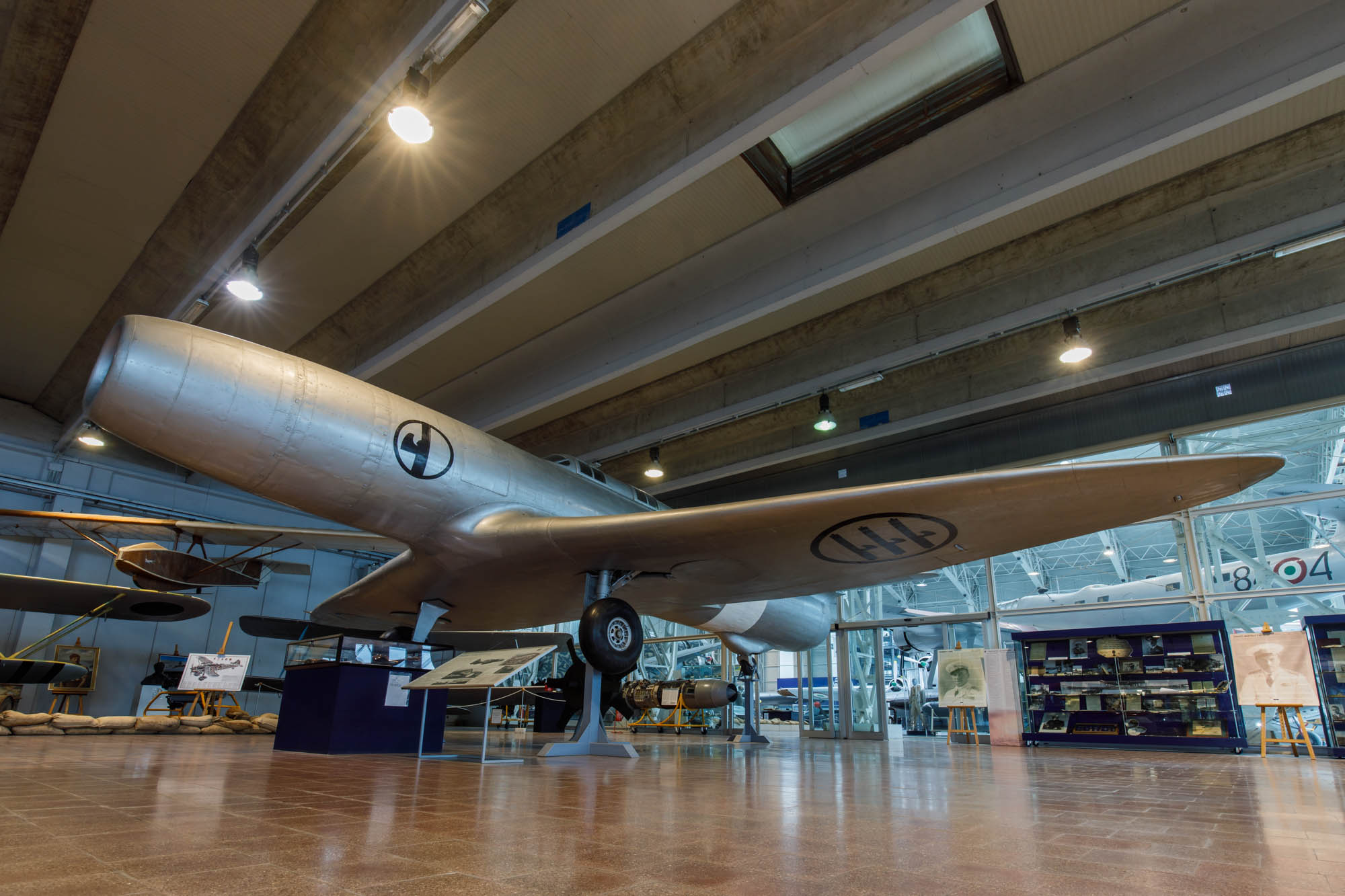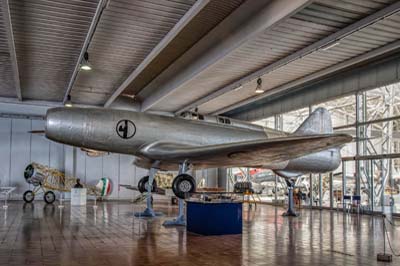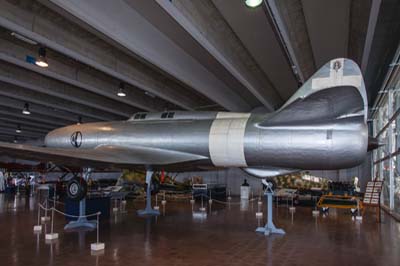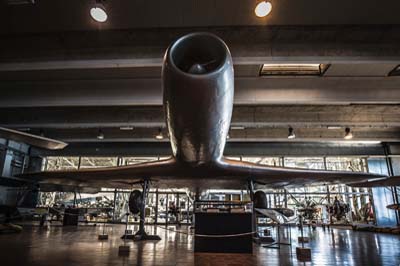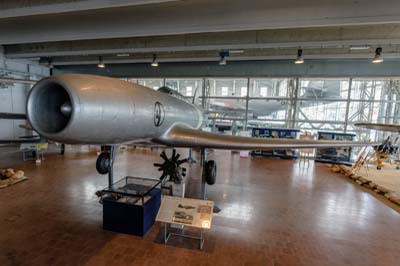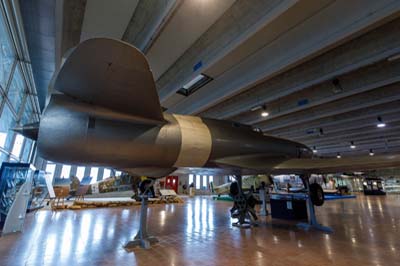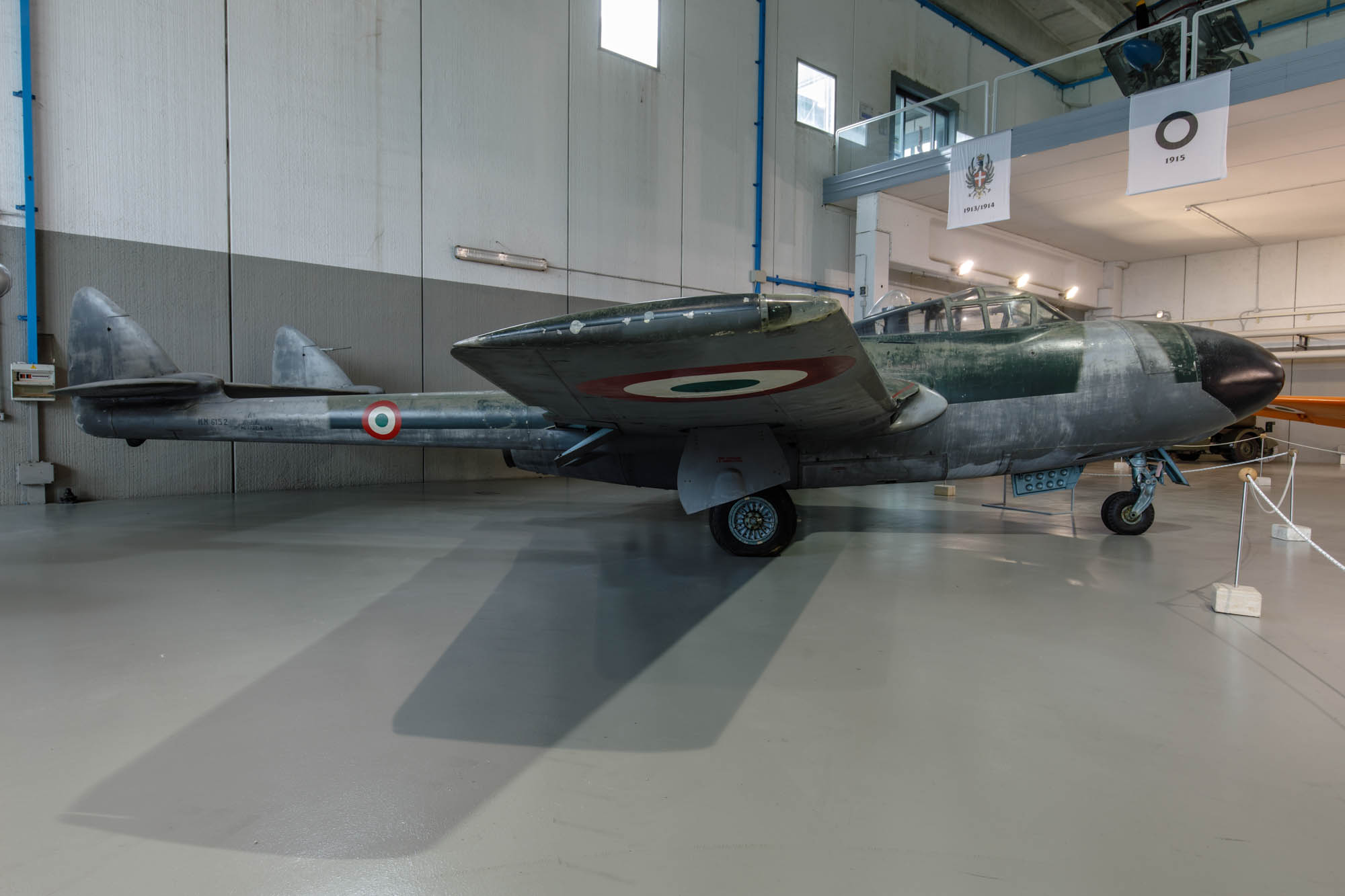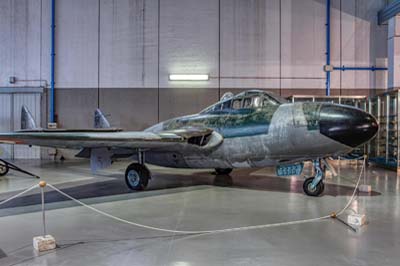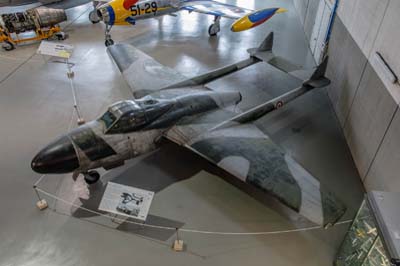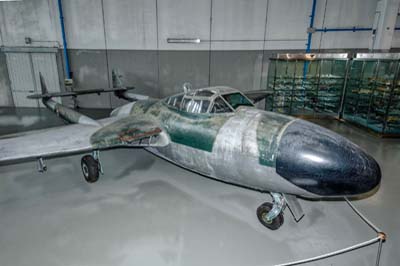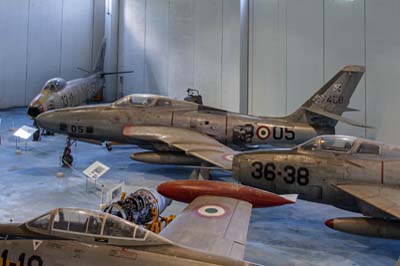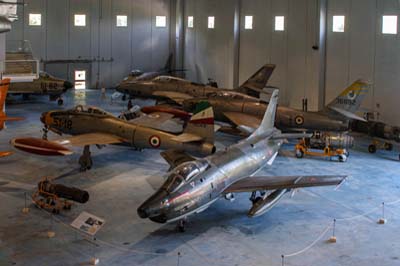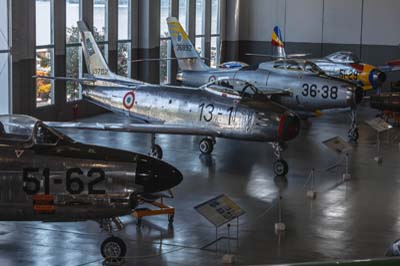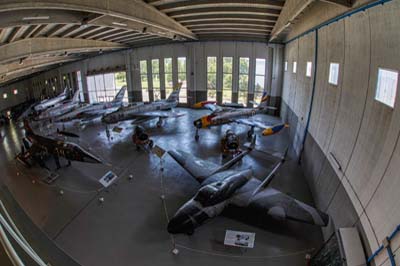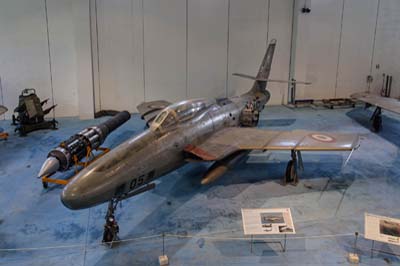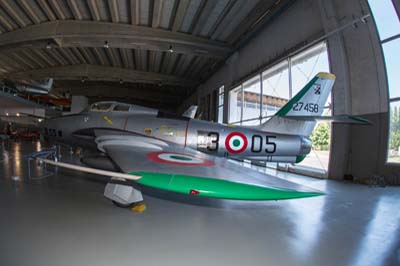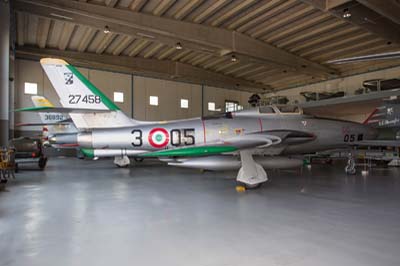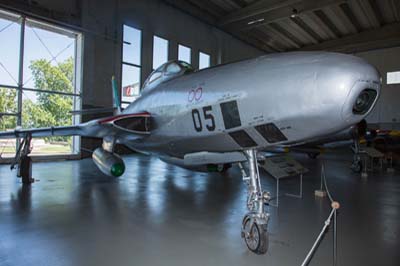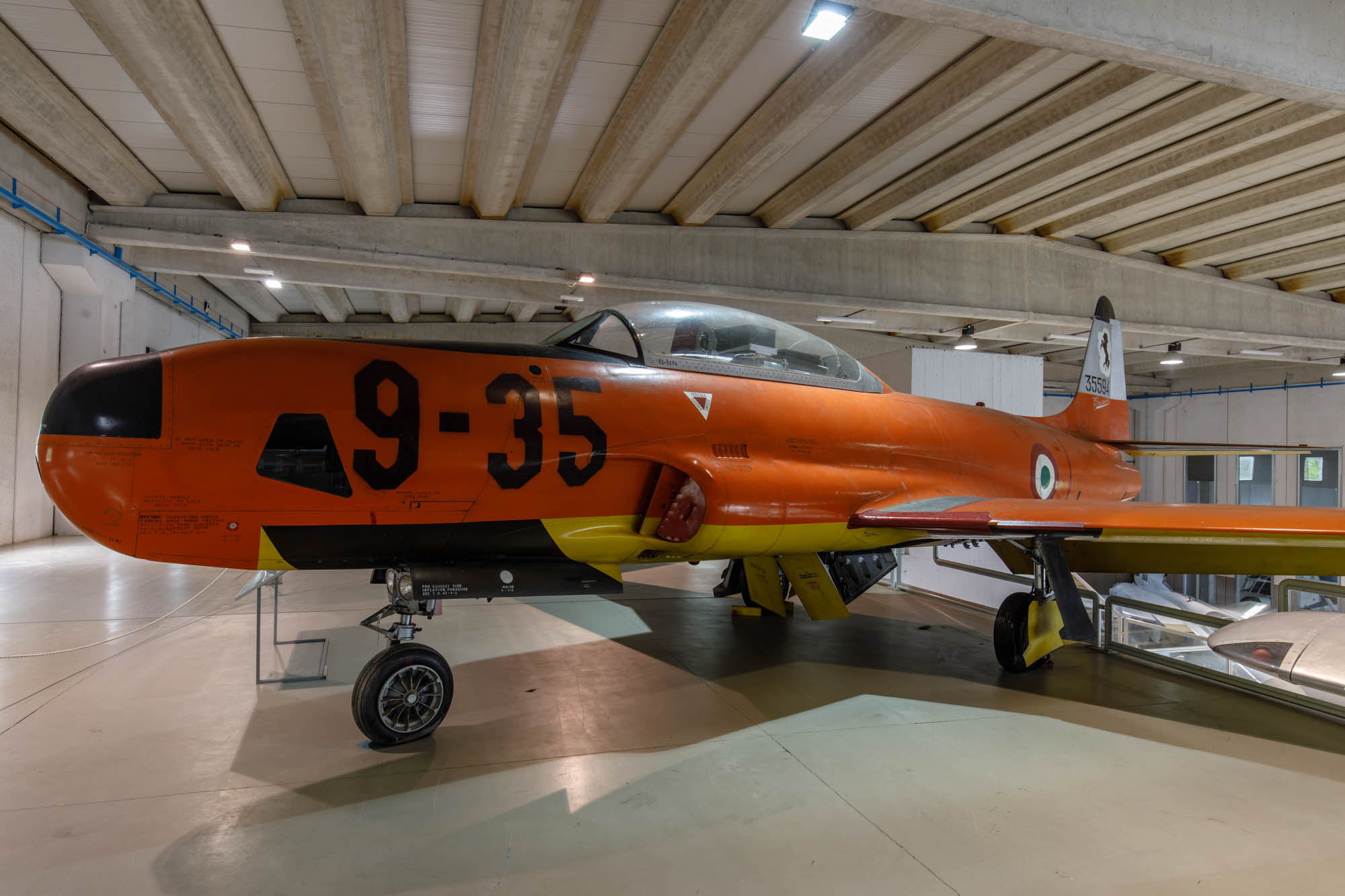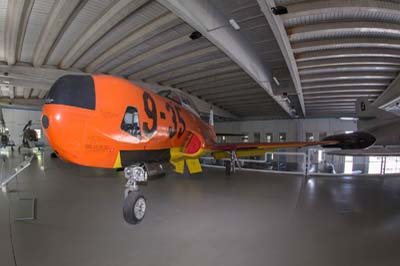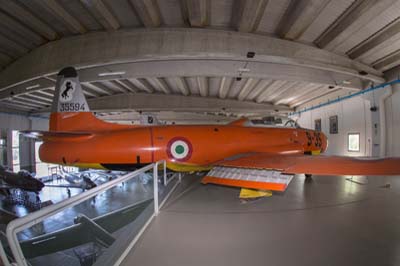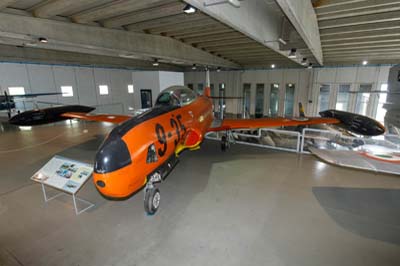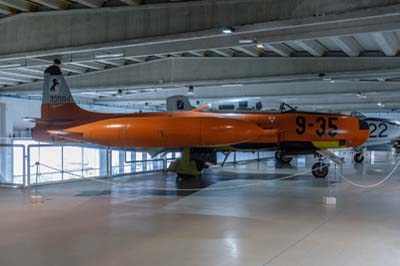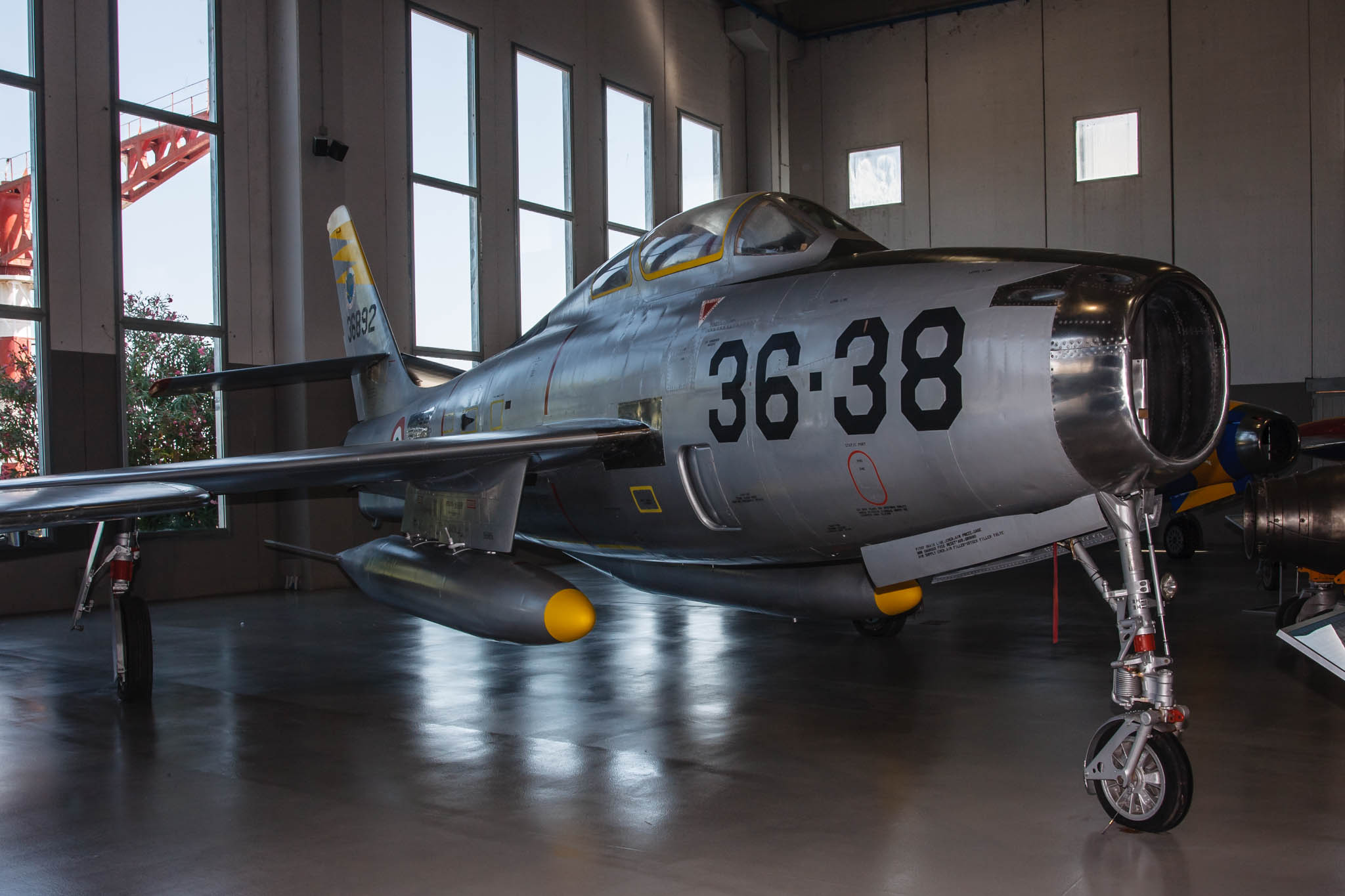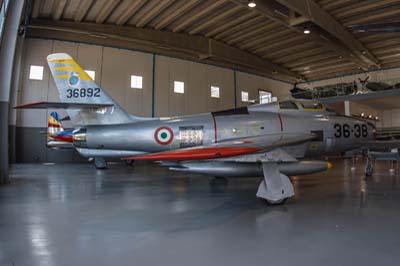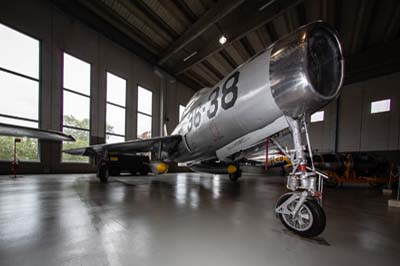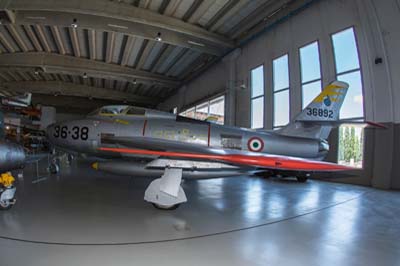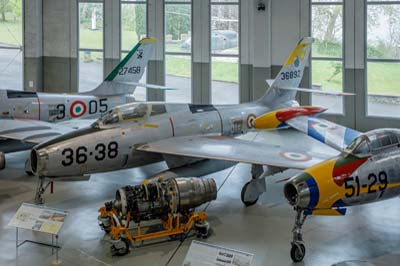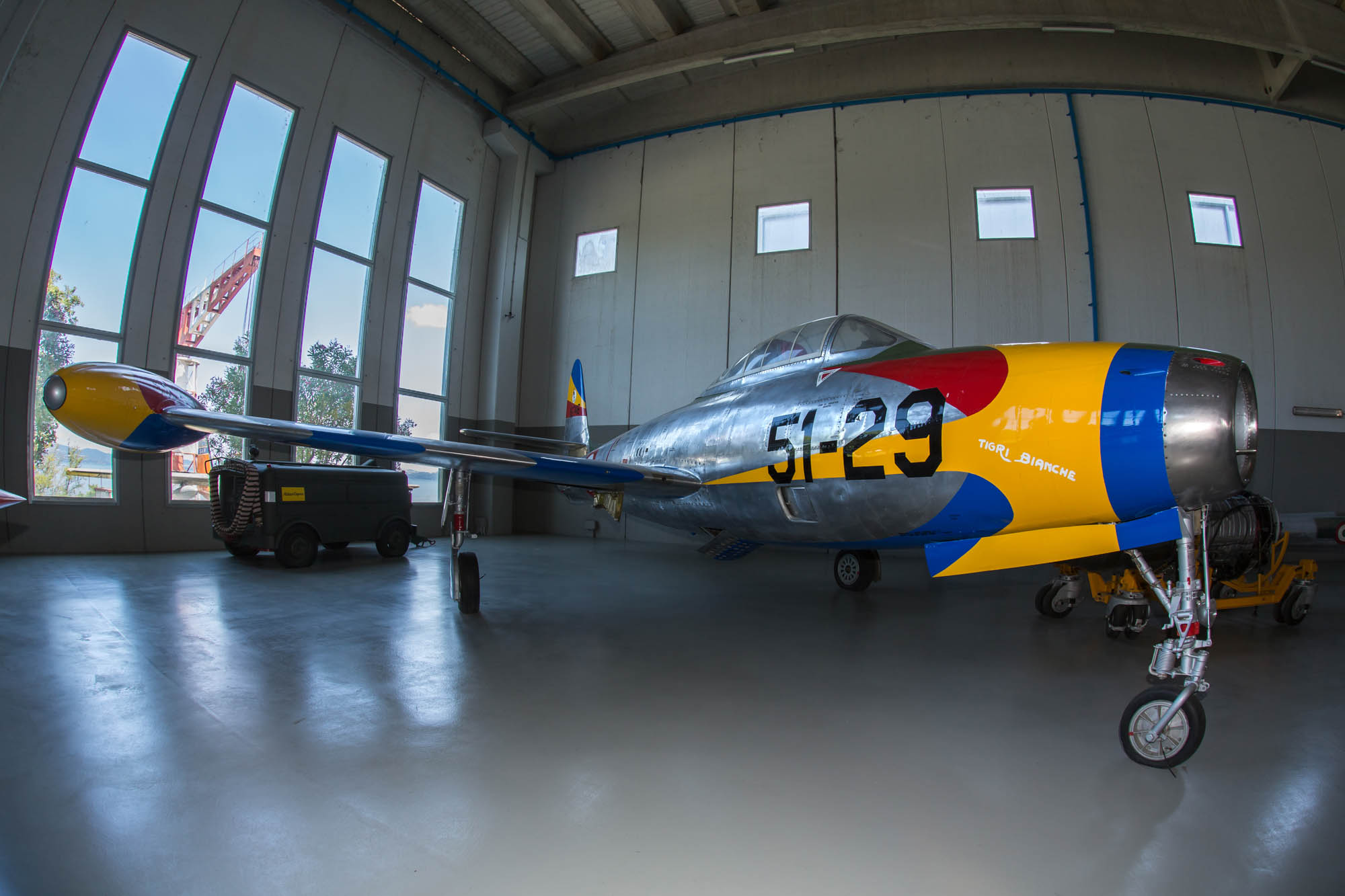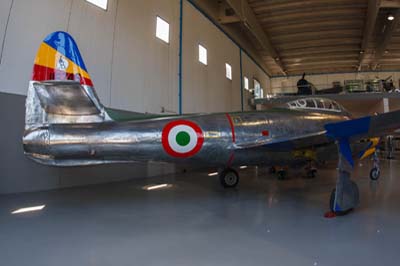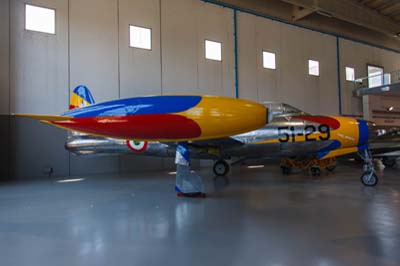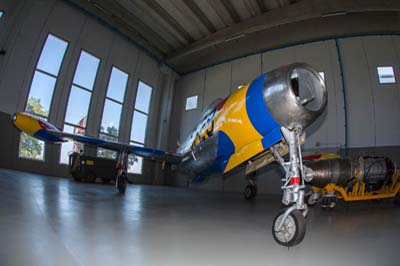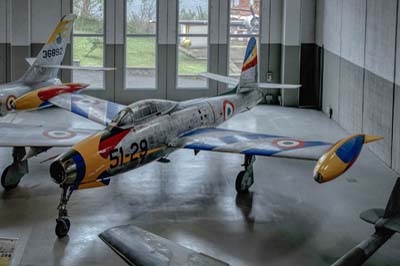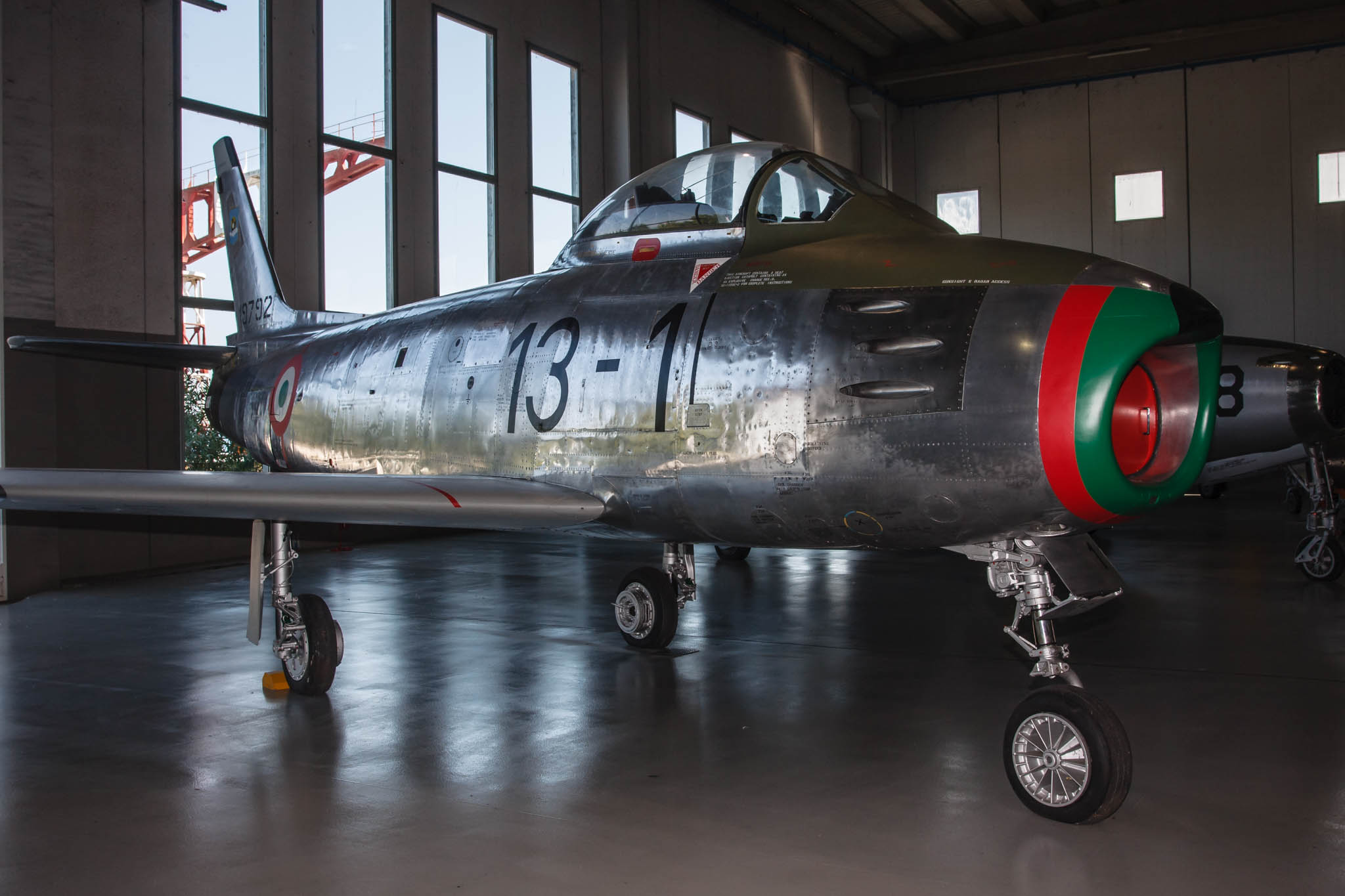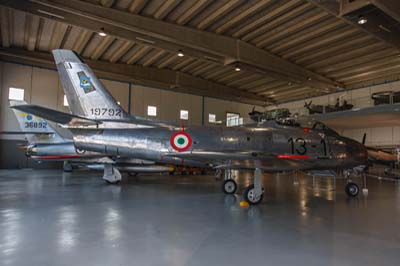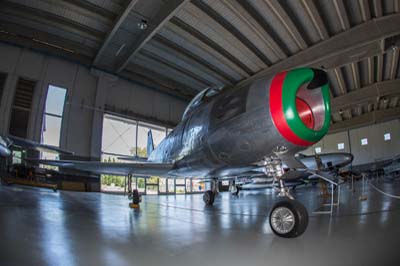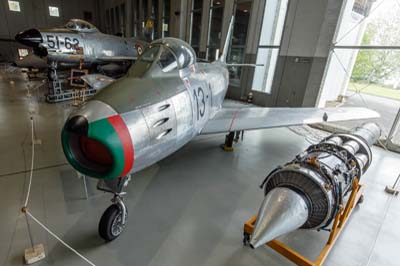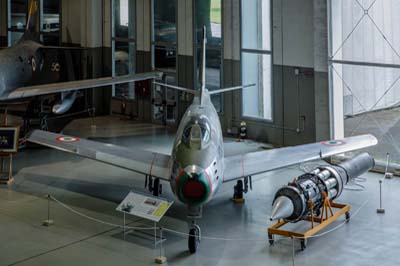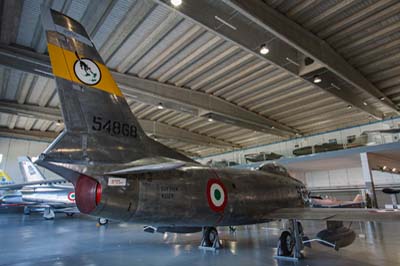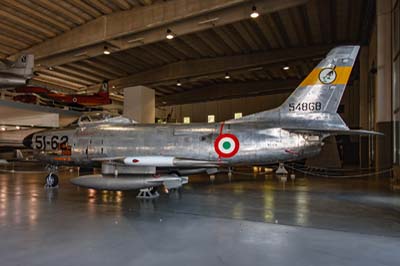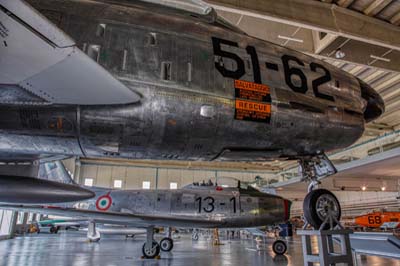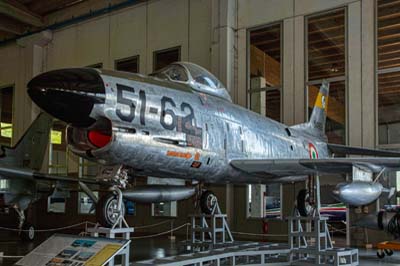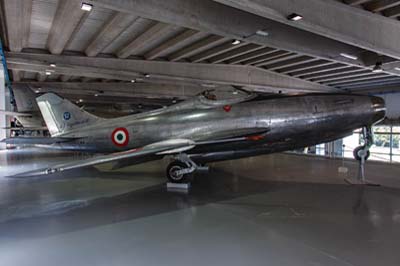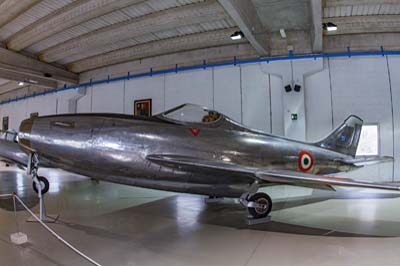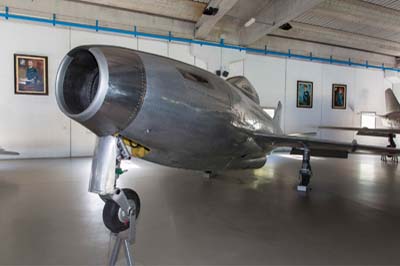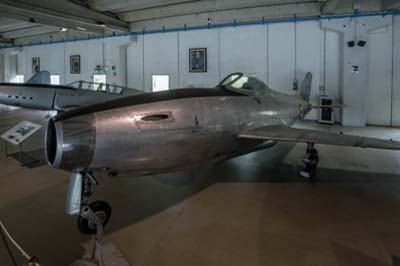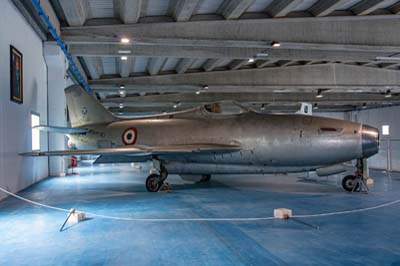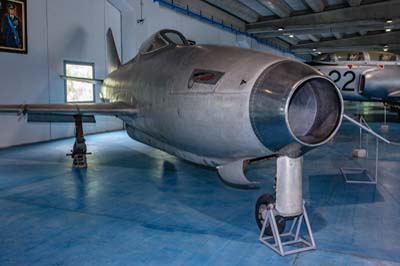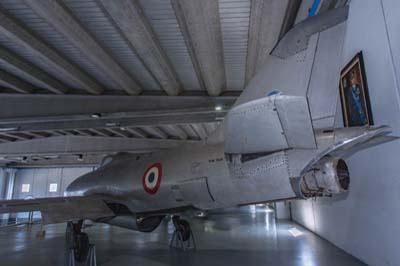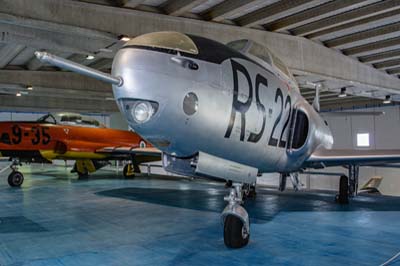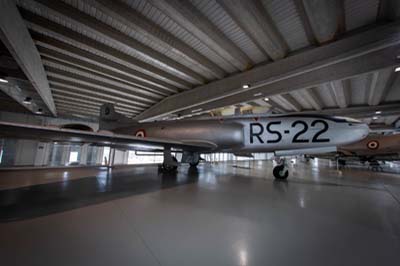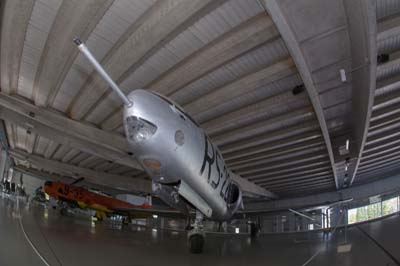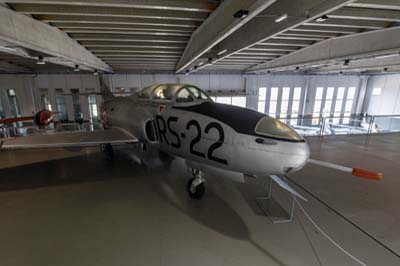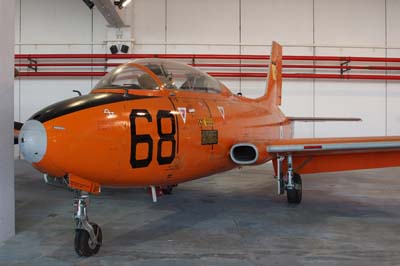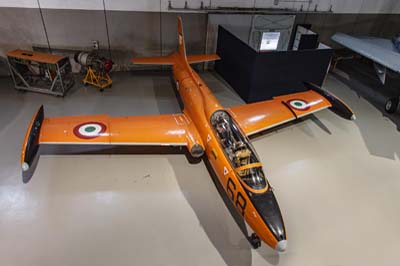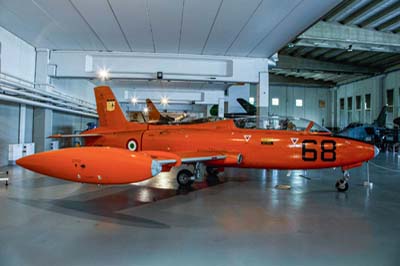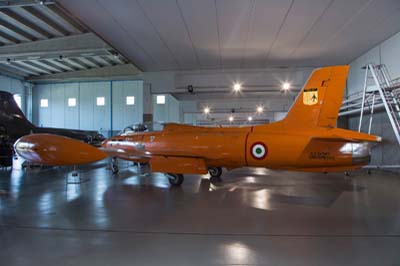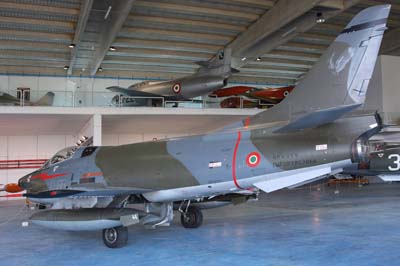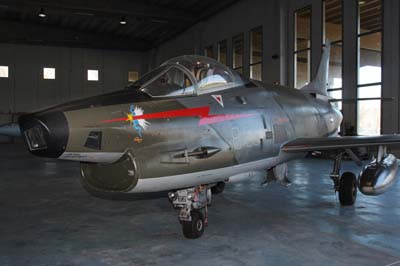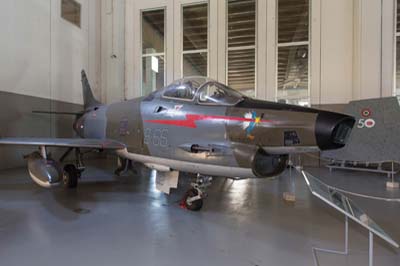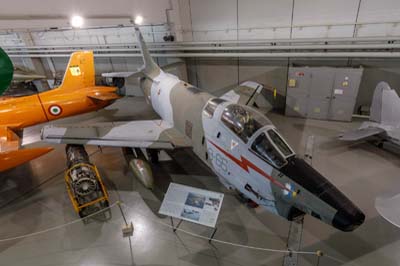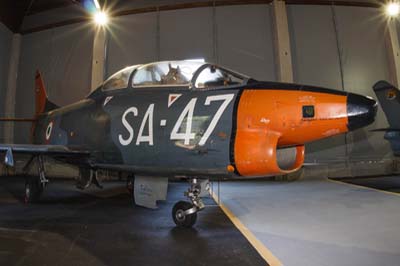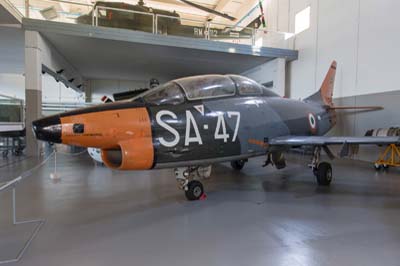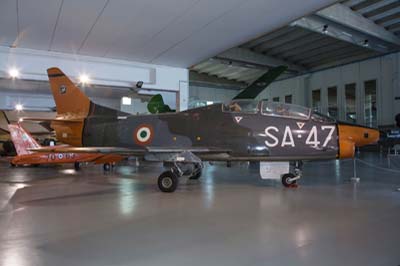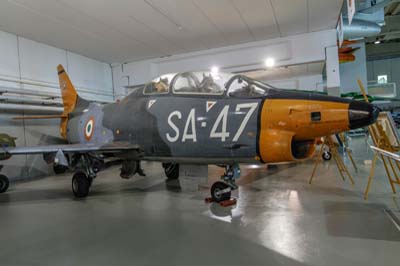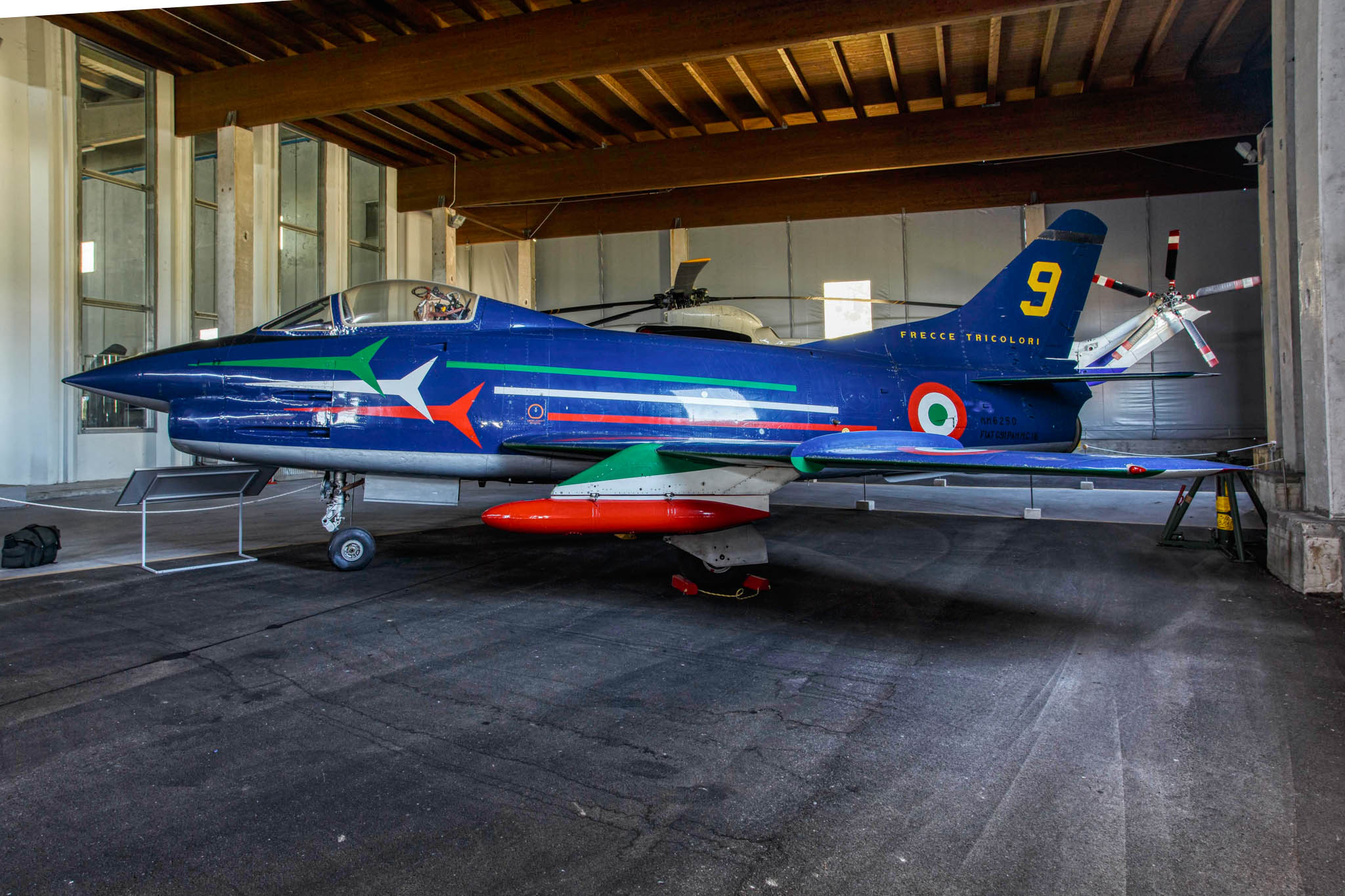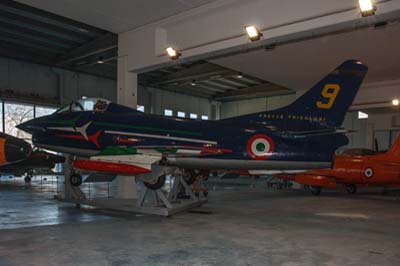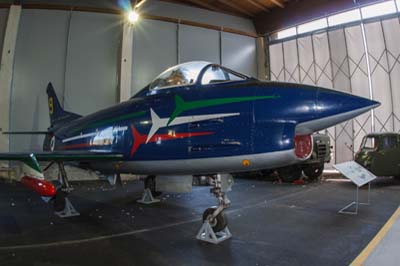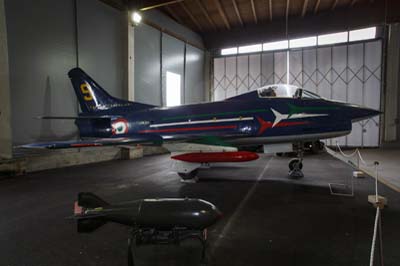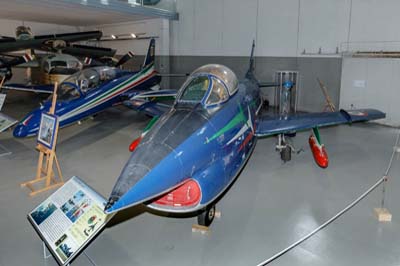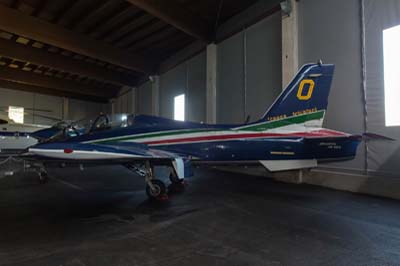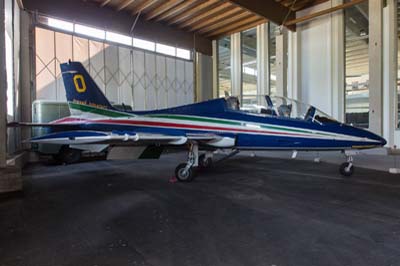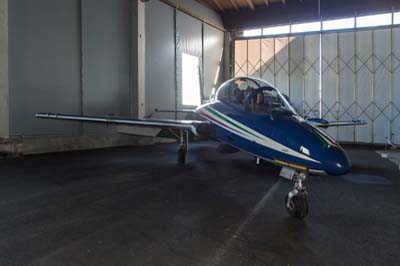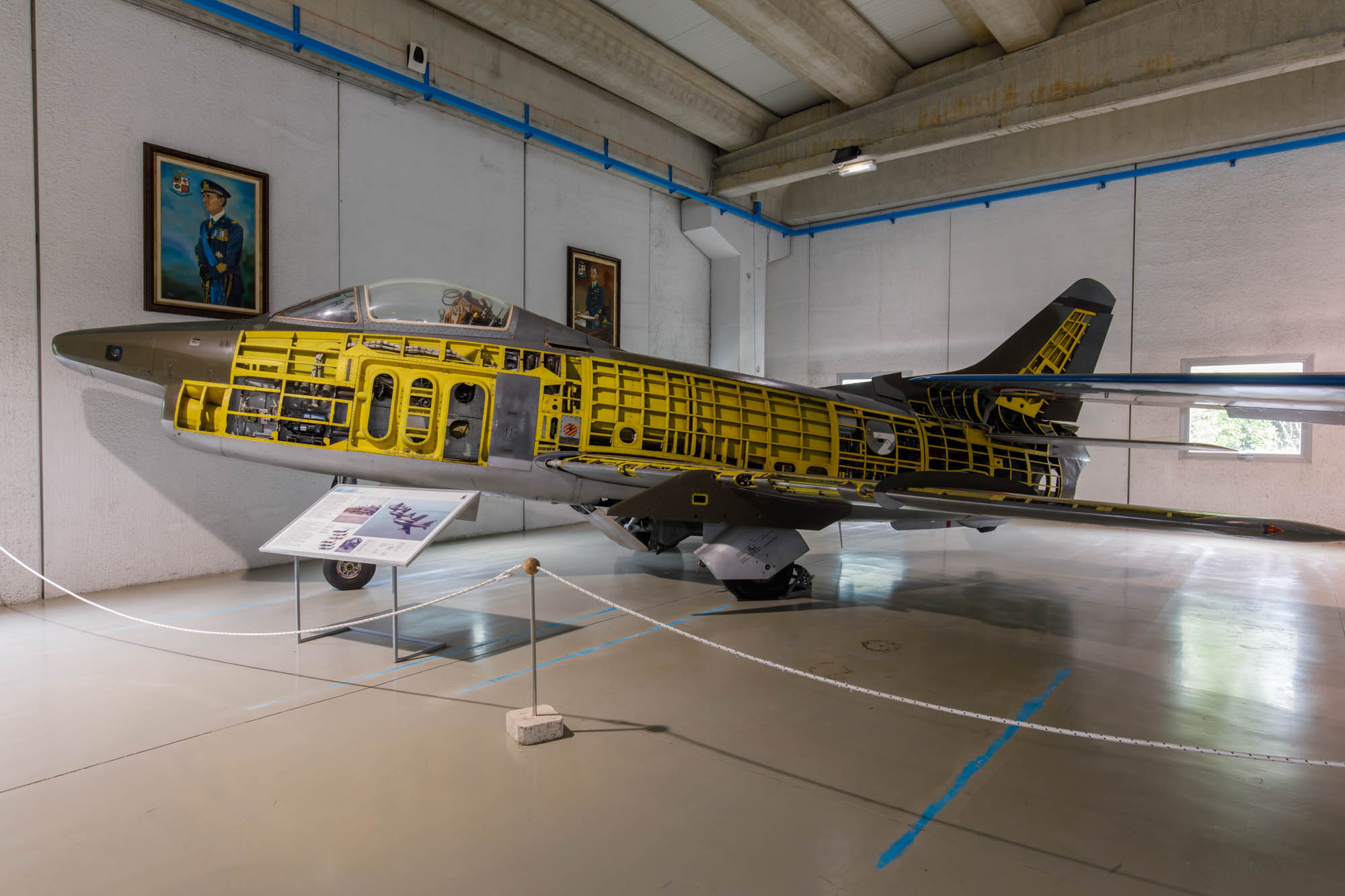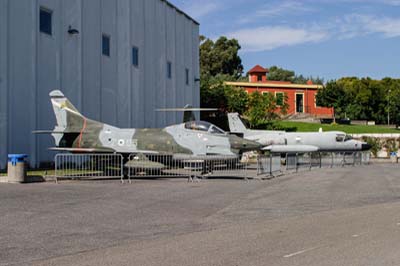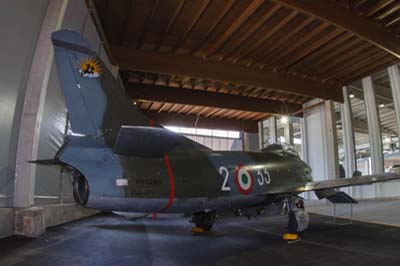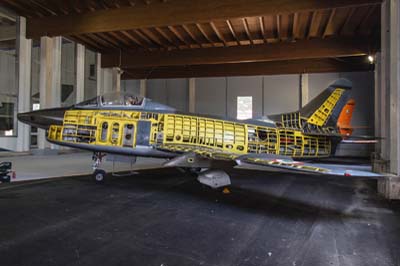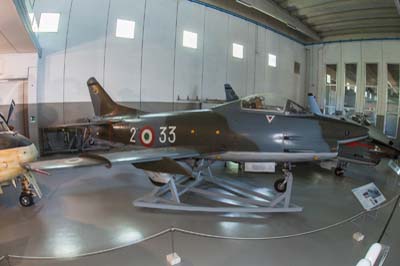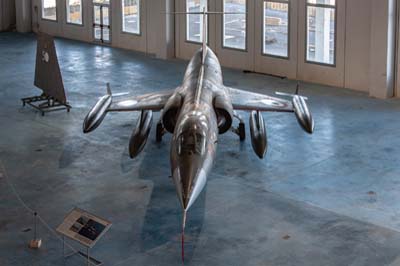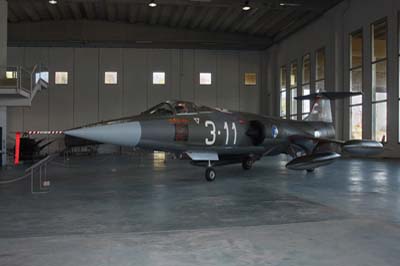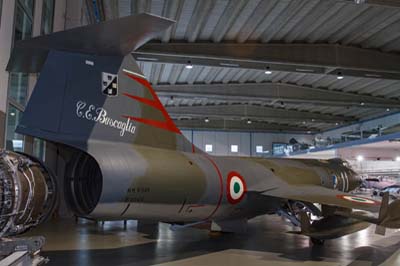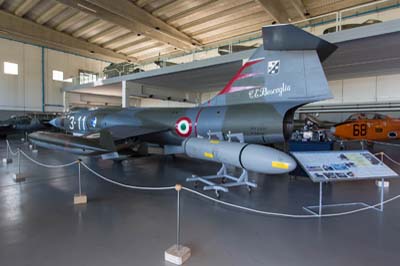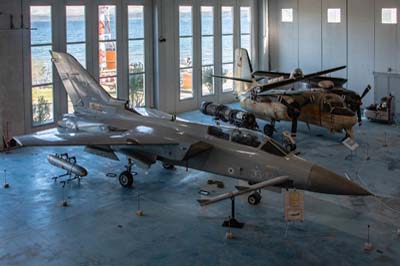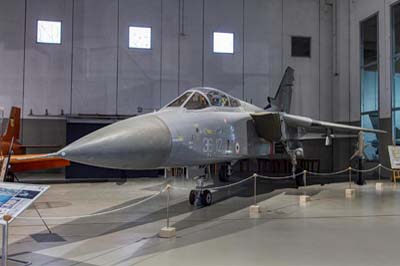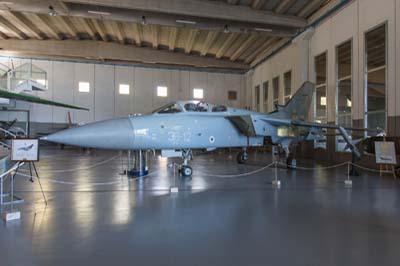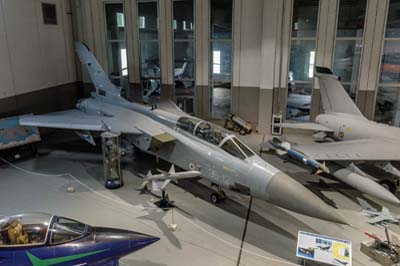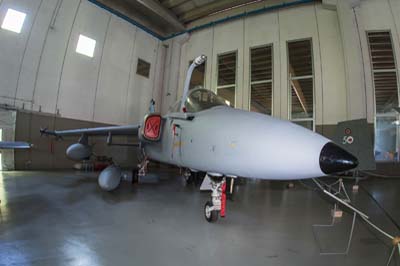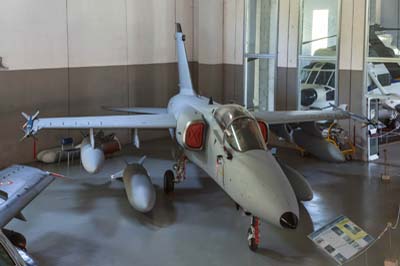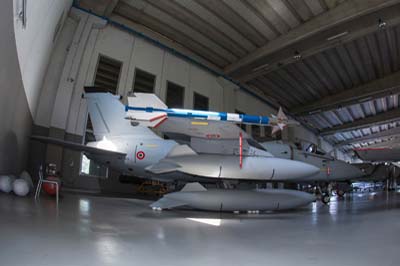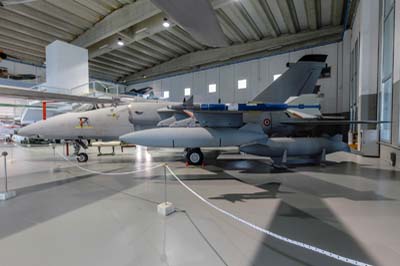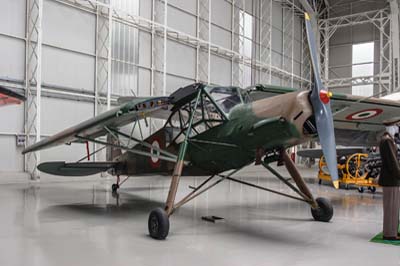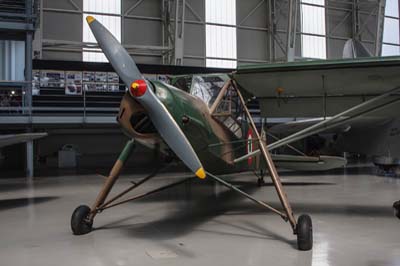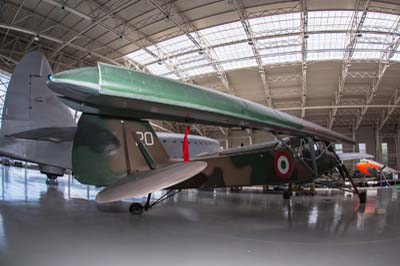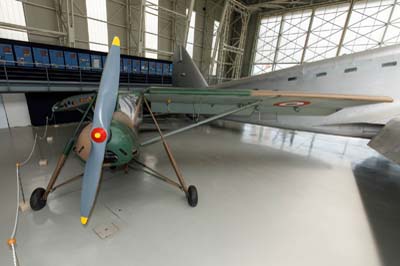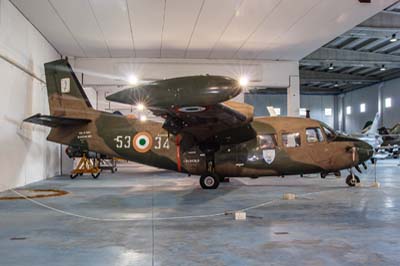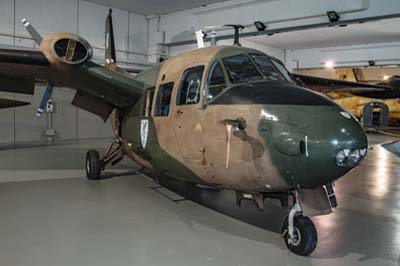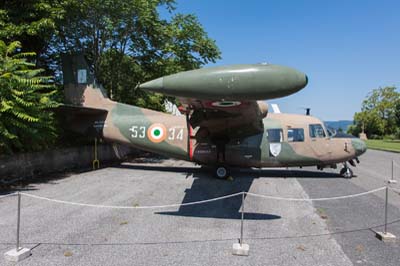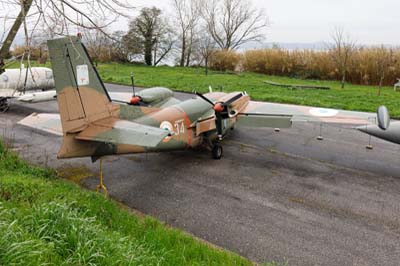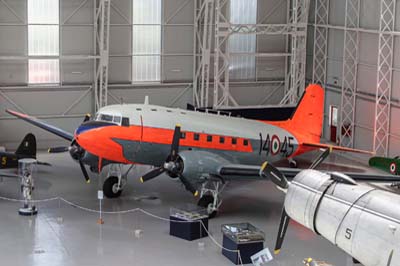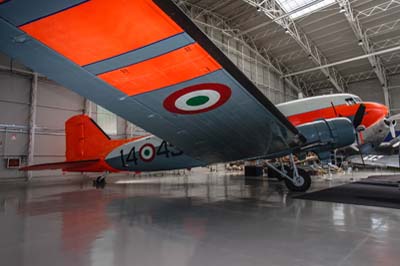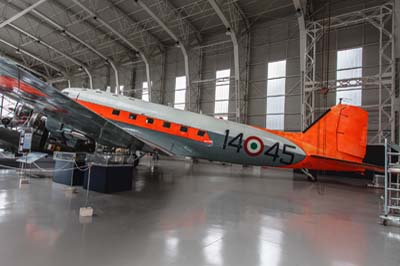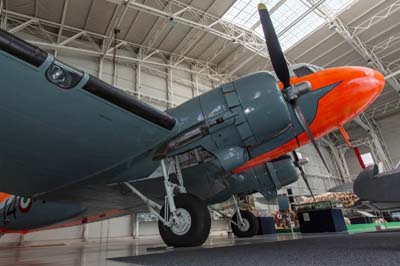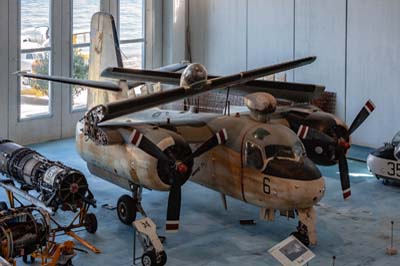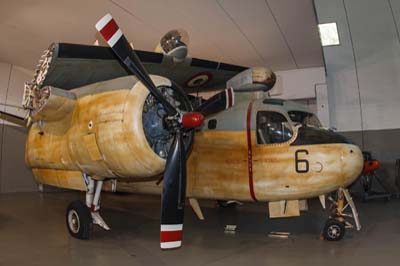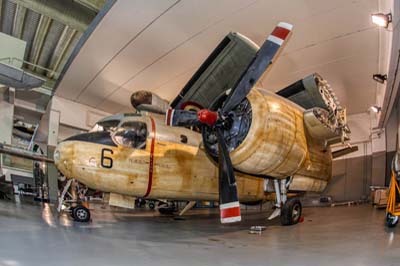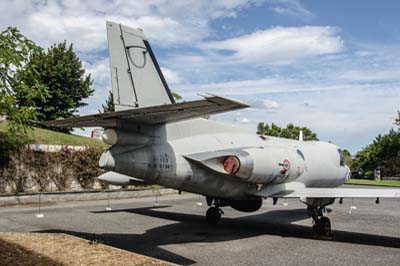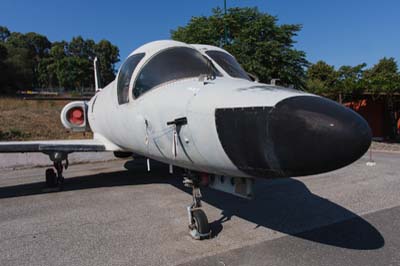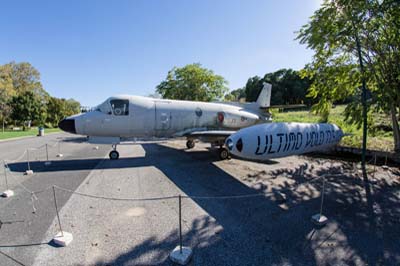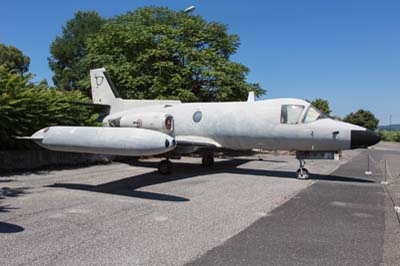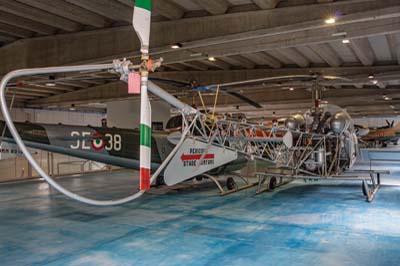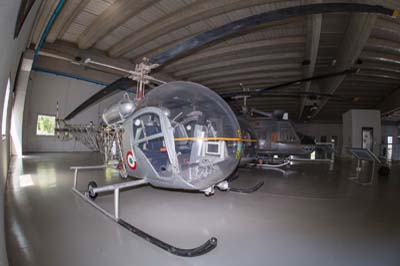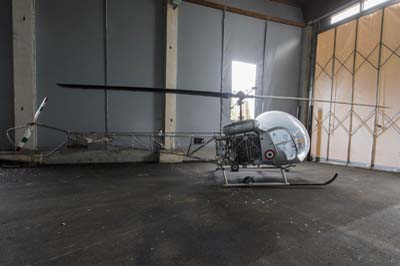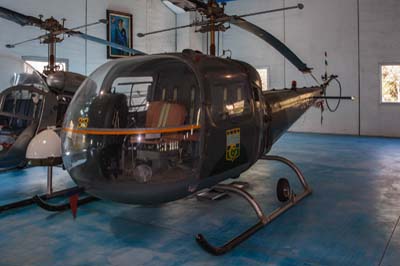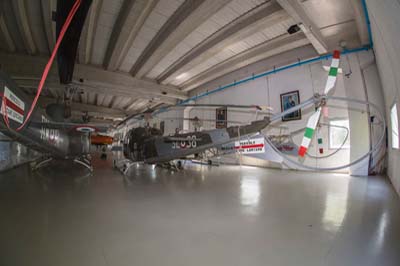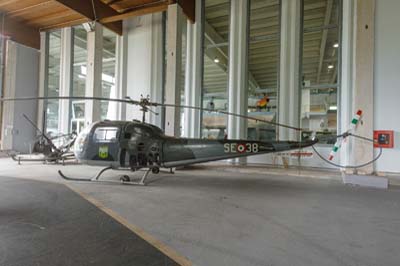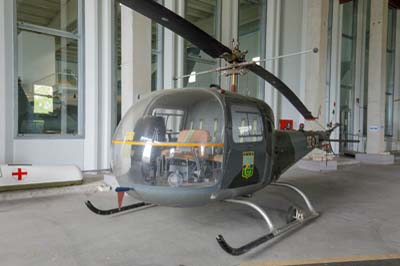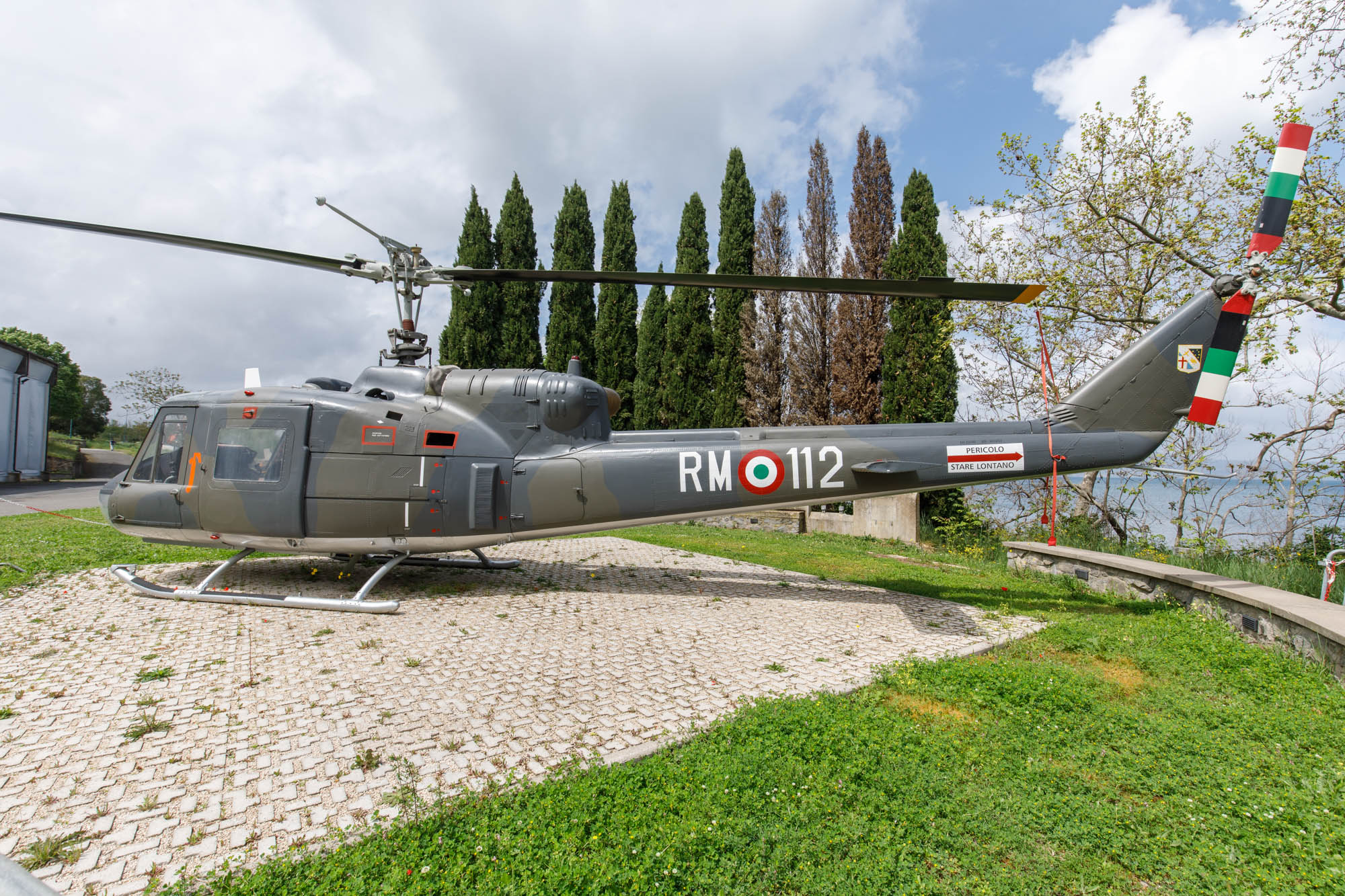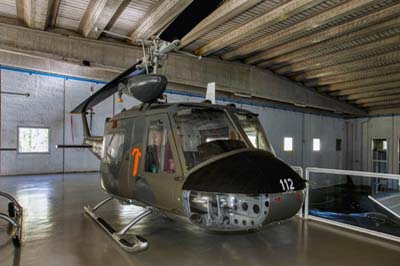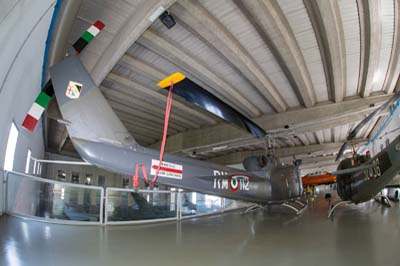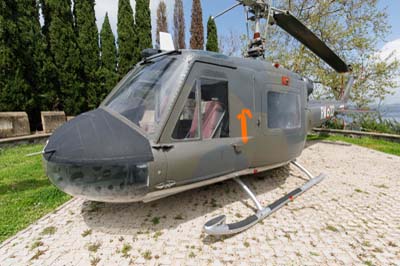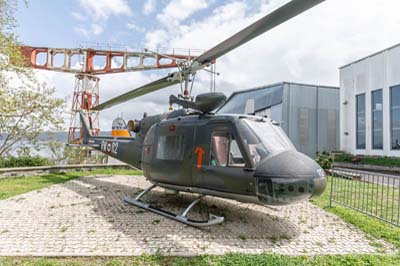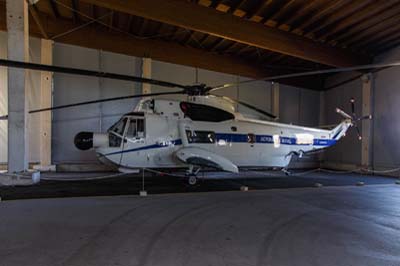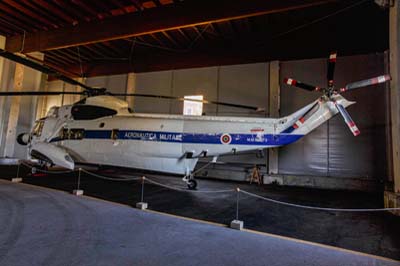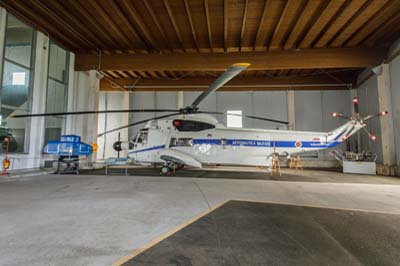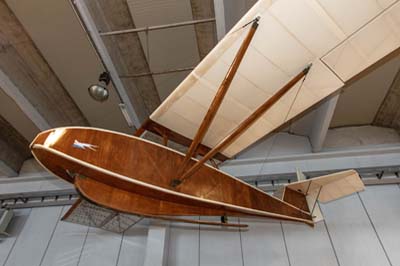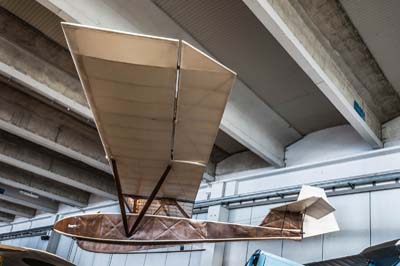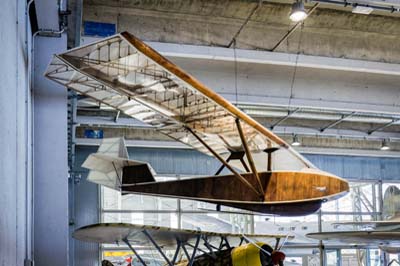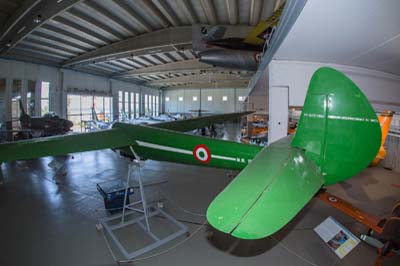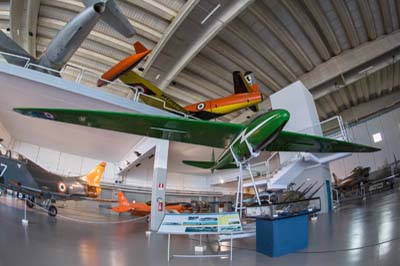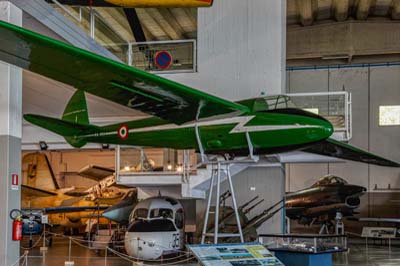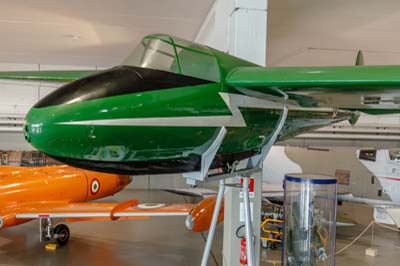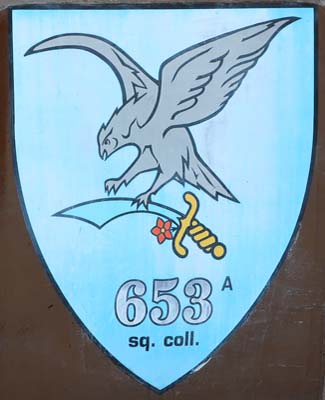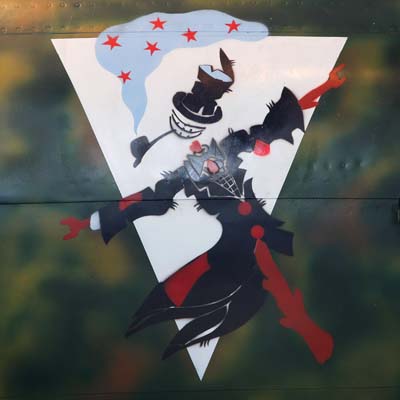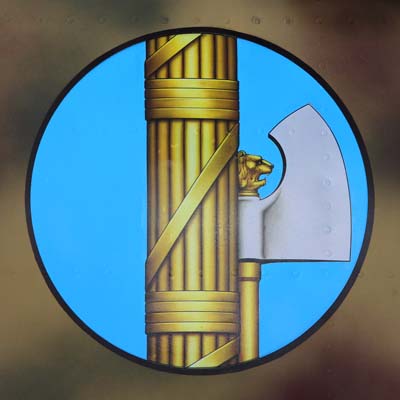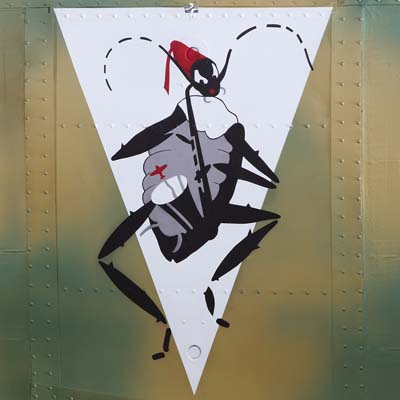The Italian Air Force Museum
(Museo Storico dell' Aeronautica Militare Italiana)
Vigna di Valle, Rome
(Continued) |
The Schneider Cup
The museum proudly presents aircraft resulting from Italy's participation in the Schneider Cup. A competition devised by French industrialist Jaques Schneider back in 1912. He wanted to promote seaplane production and offered a prize of £1,000 for the first team to win three of five races. The first competition held in 1913, at Monte Carlo, was won by a French pilot in a Depurdussin monoplane, at an average speed of 47.5 mph (76 Km/h) over the 31 mile (50 Km) triangular course. The Schneider Cup was then run annually, with a break for the World War One, till the final race held in 1931. |
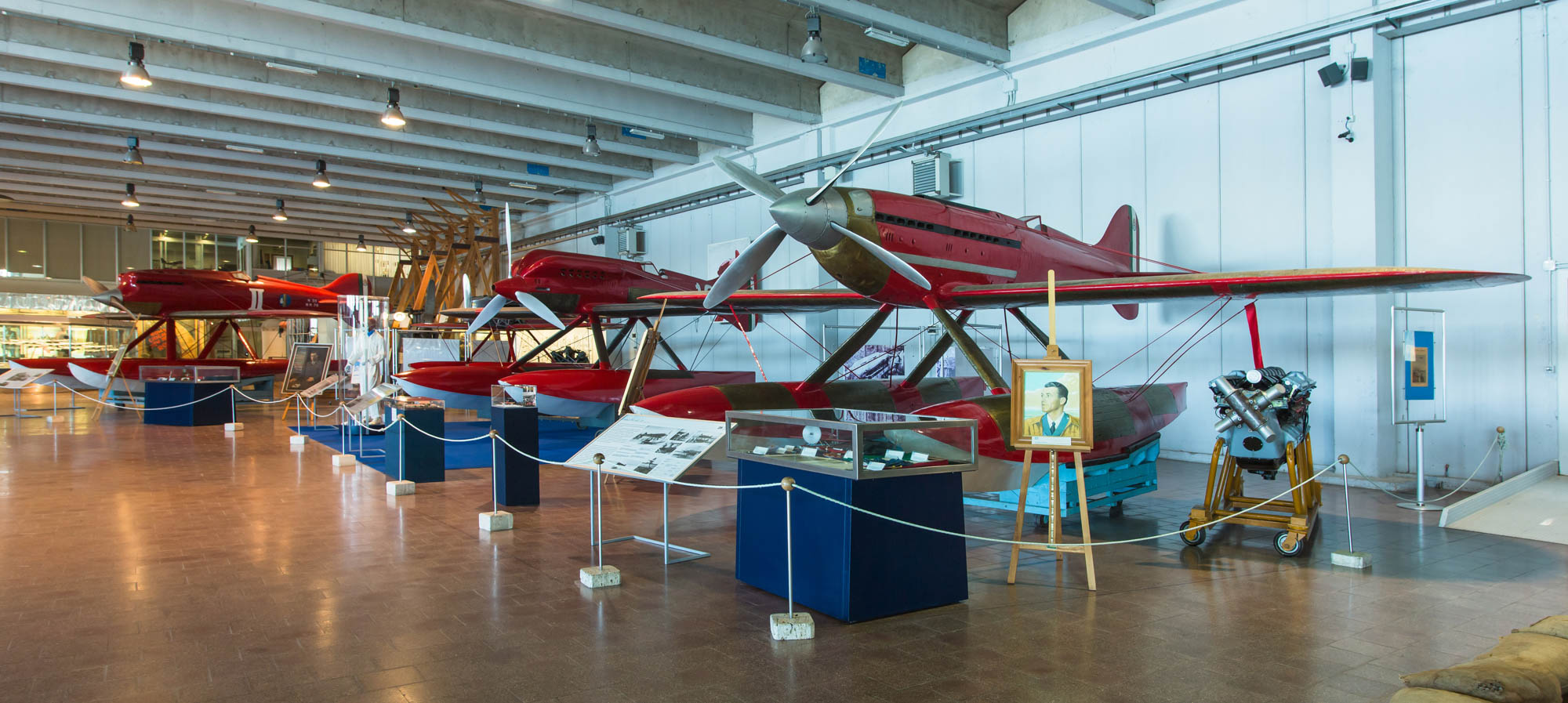 |
On display is the 1926 Schneider Cup winning aircraft, the Macchi M.39 (MM76 'II') in which Major Mario De Bernardi flew at an average speed of 247.5 mph (396 Km/h) over the course at Norfolk, U.S.A. This was the last race an American team took part in and was the final Italian victory.
On dispaly is also the Macchi M.67 (MM105) carrying Schneider Cup entrant number '10'. It was the third M.67 type constructed and was derived from the M.52. It participated in the now bi-annual Schneider Cup in 1929. It achieved a speed of 351 mph (561 Km/h), but was beaten by the British Supermarine S.6, at a speed of 359 mph (575 Km/h). This aircraft was returned to Vigna di Valle, in early 2004 following a five month period of restoration, its first in 80 years, by 3º RTA (10º RMV) at Lecce and the Associazione Aeronautical Restoration of Varese. This exhibit been removed by December 2010 but had returned by 2012.
Also participating in the 1929 Schneider Cup was the second prototype Fiat C.29 (MM130 '130') which flew at a maximum speed of 350 mph (560 Km/h). It also forms part of the museum collection and is the oldest Fiat in existence today. MM130 was also restored by 3º RTA (10º RMV) at Lecce.
In what turned out to be the final race in 1931, the British on the back of two previous wins entered the improved Supermarine S.6 and the S.6B which won at an average speed of 342 mph (547 km/h). Italy had entered the Savoia-Marchetti S.65 and Macchi Castoldi MC.72 but unfortunately lost two pilots, Tomaso Dal Molin and Giovanni Monti, in tragic accidents. The French who had technical problems dropped out of the increasingly dangerous event never to return. Development still continued in Italy and in 1934 Francesco Agello, in a Macchi Castoldi MC.72 (MM181) also on display achieved the world speed record for a seaplane, which still stands to this day, of 443 mph (709 Km/h). It unusually employed counter rotating propellers designed to reduce torque. |
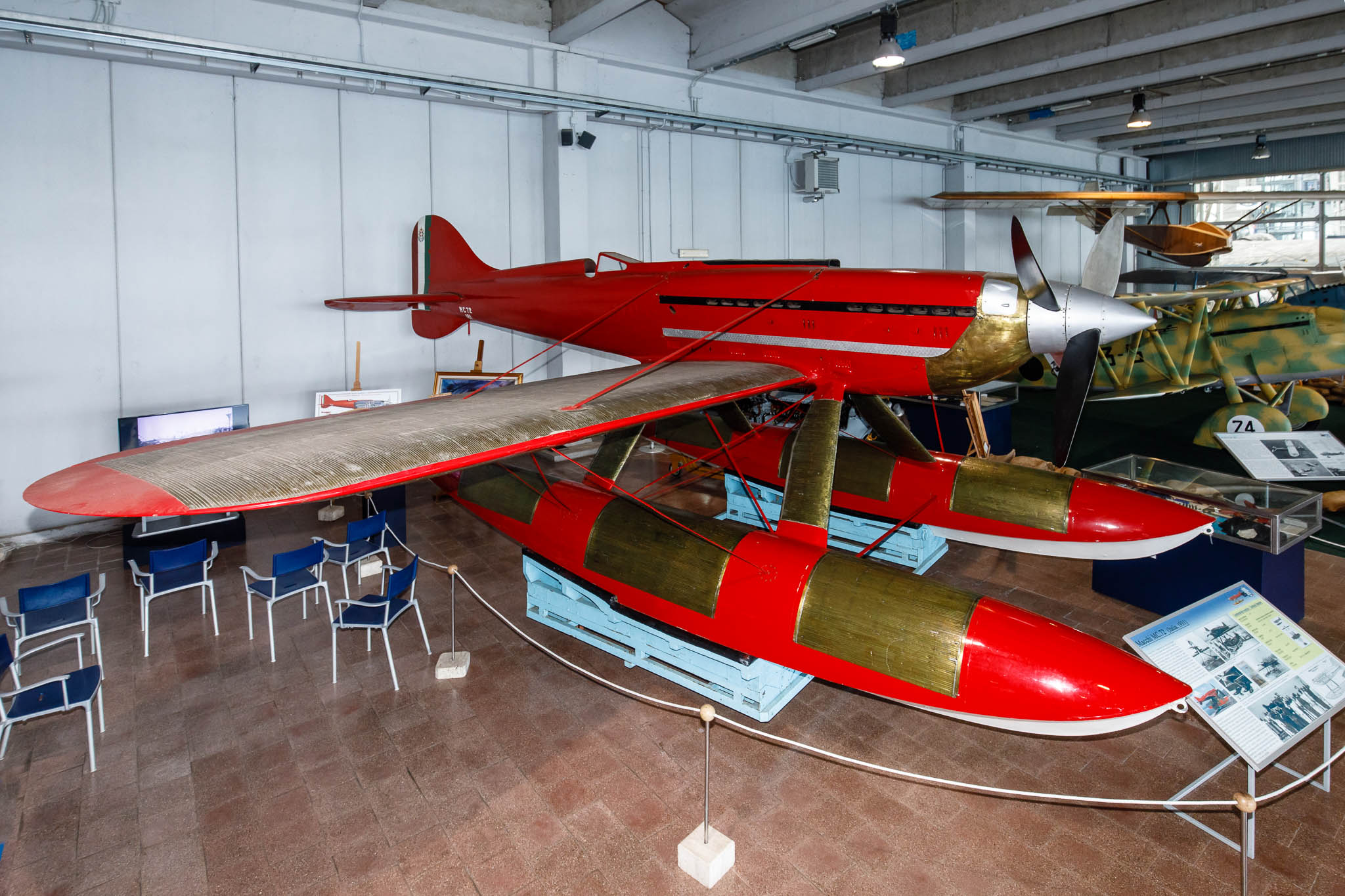 |
| Macchi Castoldi MC.72 (MM181). The world's fastest piston-powered seaplane. |
| Macchi M.67 (MM105 '10'). |
| The 1926 Schneider Cup collection of aircraft on display in 2004. |
| SAI-Ambrosini (Super) S.7 Supersette (MM558) Also built for speed and competition is the SAI-Ambrosini S.7 Supersette designed by Sergio Stefanutti. It first flew in July 1939 just in time to participate in the 'Avio Radunno del Littorio' competition against similarly fast German aircraft. Unfortunately it was not fully tested and failed to win by just a few seconds with a speed of 251 mph (402 km/h). After the War the S.7 and later the Super S.7 were developed for pilot training for the AMI. The Super S.7 on display (MM558) is the second prototype used by the Reparto Sperimentale Volo (RSV) test unit at Pratica di Mare. As photographed in; 1990 and 1996. |
Trainers, Italian Style
Last but not least a number of military training aircraft are on display, which following retirement often went to civilian aero clubs. |
Caproni Ca.100 Caproncino (I-GTAB 'FIR-9') registered in 1951 it had been operated by Aero Club Torino. The Ca.100 was based on the DH.60 Moth and over 700 were built between 1928 and 1937 they were used extensively by flying schools basic pilot training. The aircraft on display returned to the museum on May 24, 2007 and is painted in markings representing a Ca.100 with the Florence basic flying school of the 1930s. It had previously been at the museum for a short period around May 1991.
A Caproni Ca.100 Caproncino idro (MM65156 'COM-11' ex I-ABOU first registered in 1929 and cancelled in 1935), a version equipped with floats, was on display for a short while in 2002. Normally based at Como Aero Club, it was on loan from Gavazzi Gerolamo. |
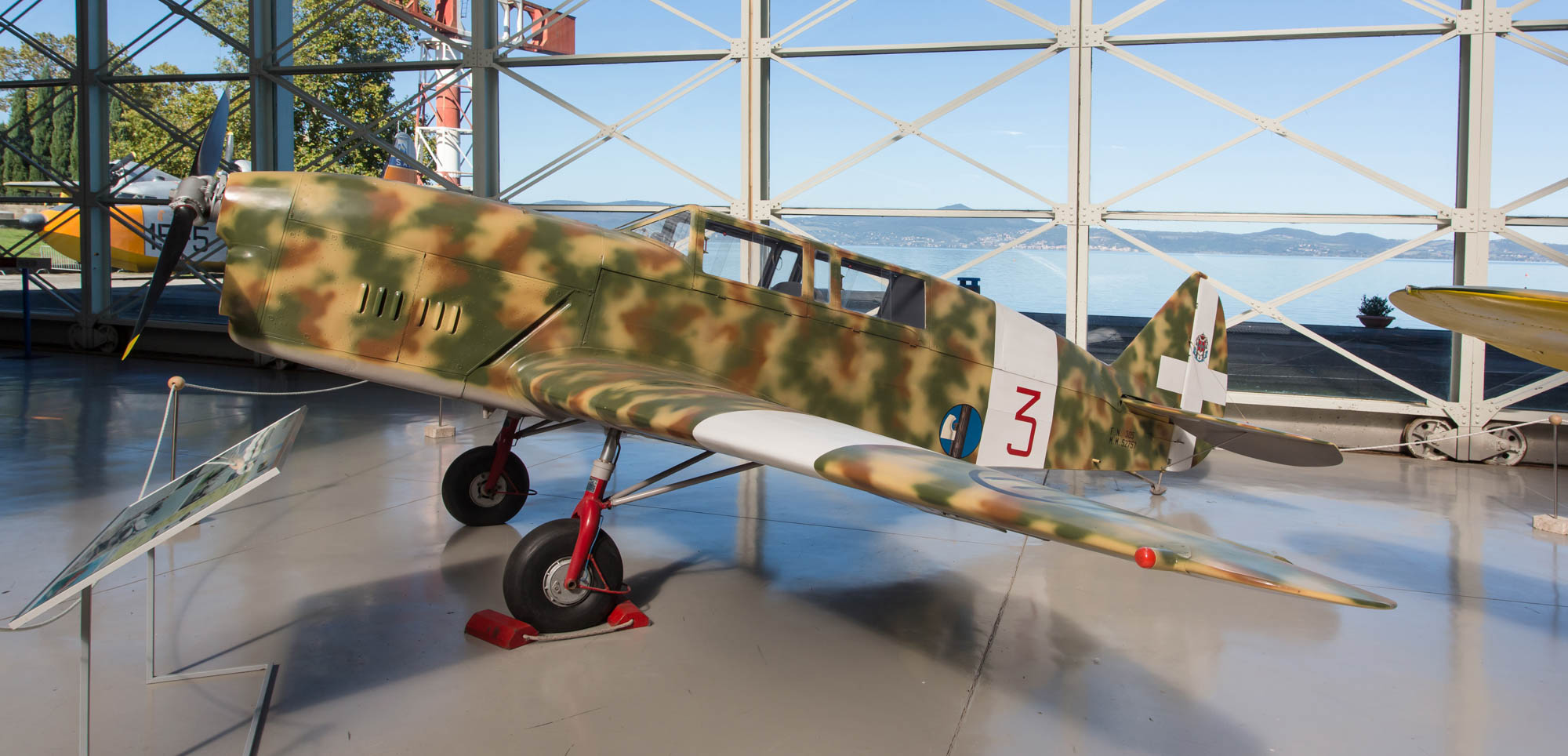 |
| The Nardi FN.305 The Nardi FN.305 was designed by the four Nardi brothers in 1933 and made its first flight in 1935 from the Milan – Bresso airfield. Originally powered by Fiat A70 190 hp radial engines, the later Italian Air Force machines were powered by Alfa Romeo 115-1 190 hp engines and included an enclosed cockpit. They were used as advanced trainers and for liaison duties during the War. Piaggio later made these aircraft under license. The example on display (MM52757 '3' it was previously I-DASM) is painted in colours dating from 1940-41 when based at Perugia. It was restored by GAVS in Rome between 1994 and 2000 and is the only surviving example. As photographed in; 1990 and 1993. |
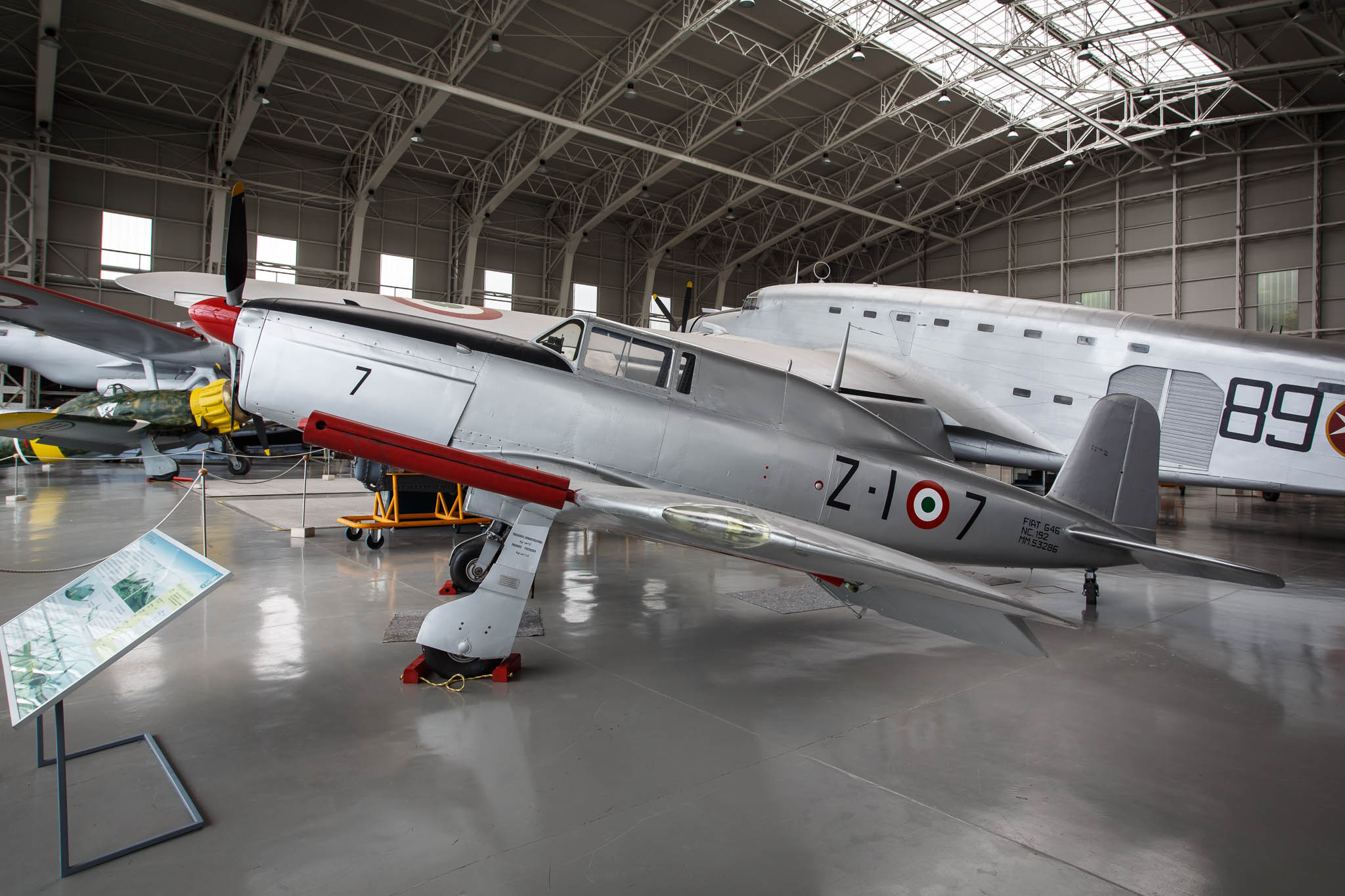 |
Fiat G.46-4A (MM53286 'Z-17' ex I-AELM c/n 192) The G.46 is of aluminum construction was designed by Giuseppe Gabrielli as a two seat trainer, sitting in tandem. There was also a single seat version. The G.46 first flew in 1948, before going into production in the following year. The Italian Air Force received 141 aircraft. 70 of these aircraft were passed on to Italian Flying Clubs by the end of the 1950s and remained in use till the 1970s. Today only five G.46s remain airworthy, apart from two in Italy (MM53491 registered I-AEKT and MM53304 registered I-AEKA at Montegaldella November 2004), there is G-BBII (ex MM52801 registered I-AEHU) from the Aircraft Restoration Co, Duxford (since 1992), US based N46FM (MM53091 registered I-AEHX) and OO-VOR (ex MM53293 registered I-AEKI) of the Vormezeele Collection in Belgium. Fiat G.46-4A (MM53283) was here in 1983.
This exhibit was first observed in 1980 and was on display until noted in 1996 after which it went to Pratica di Mare where it performed taxi runs at air shows. It returned after restoration at Lecce/Galatina in October 2011. |
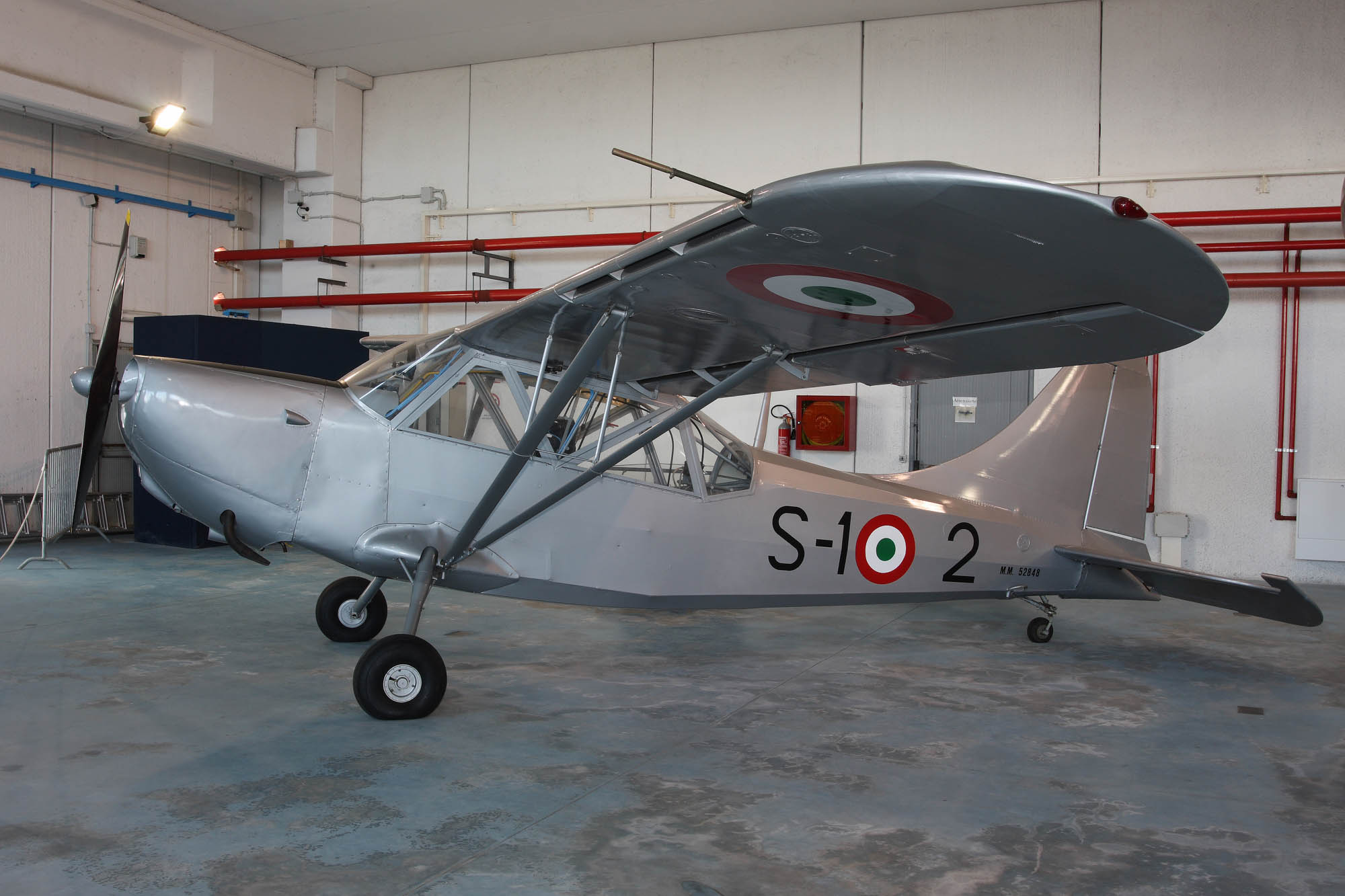 |
| Stinson L-5 Sentinel (MM52848 'S-1 2' it was previously I-AEEU registered in 1954) previously operated by Ministero della Difesa - Aeronautica it was recovered from the Aero Club at Turin and restored. Around 100 of these aircraft were used by the AMI for basic training from 1946. As photographed as I-AEEU in 1990. |
| Aermacchi MB.308 Macchino (MM53058 'SG-8' it was previously registered I-GORI in 1950) it had been operated by Ministero della Difesa - Aeronautica. A side-by-side basic trainer of wooden construction with a tricycle landing gear, it first flew from Venegono in 1947. The AMI ordered 80 MB.308s and operated them until the 1950, when 40 aircraft were transferred to civilian flying clubs from whom they served well until the late 1960s. |
| Another Italian light aircraft on show, is the Macchi M.416 (MM53762 'AA-48' it was previously I-AELY when registered in 1962) and was supplied as a basic trainer for the Italian Air Force from 1951. Originally designed by Fokker as the S.11 'Instructor', as a side-by-side light trainer, it made its first flight in 1947. 178 M.416s were license built by Macchi, subsequently, following development of better performance aircraft, the AMI passed them on to aeroclubs throughout Italy. As photographed in 1996. |
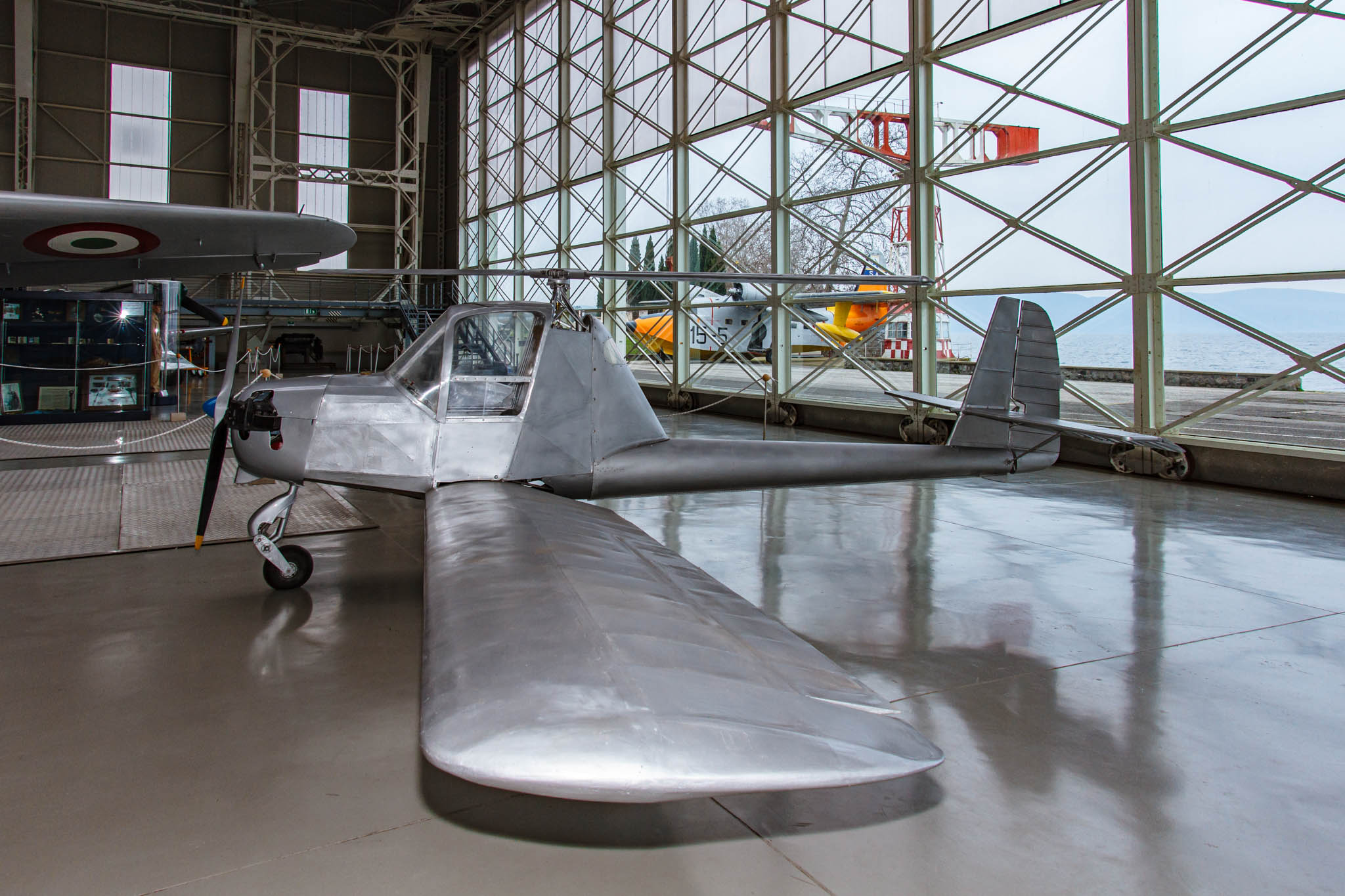 |
Partenavia P.63 De Bernardi Aeroscooter MdB1 (I-REDI) this prototype was designed by Mario de Bernardi (1893-1959) and built by Partenavia in the 1950s. It is a low-wing monoplane with a fixed nose-wheel landing gear. The two-bladed rotor was designed to reduce the stalling speed should the Ambrosini P-25 piston engine fail. It is one of only three built (this MdB1 single-seat and MdB2s I-SELI and I-FJOR which were two-seaters). The MdB1 first flew on April 2, 1951 and the MdB2 (I-FJOR) made its first flight in April 1959 at Rome Urbe. De Bernardi on April 8, 1959 was demonstrating his Aeroscooter when he appeared to land his aircraft without full control. Rushing to the aircraft beside the runway De Bernardi was found to have had a heart attack during flight and had just managed to land his aircraft and the famous aircraft designer had died. MdB2 (I-SELI) flew in 1961 and is on display at the Museo Aeronautico Caproni di Taledo in Milan.
The MdB1 'car' (I-REDI) was on display in 1980 and again in 1991 for a short while, it had not been seen until it had been restored by volunteers from the Associazione Nazionale Personale Aeronaviganti (ANPAN) and put on display once again on May 31, 2010. By June 2023 it had been removed from display, possibly placed in the new museum store at Piacenza. |
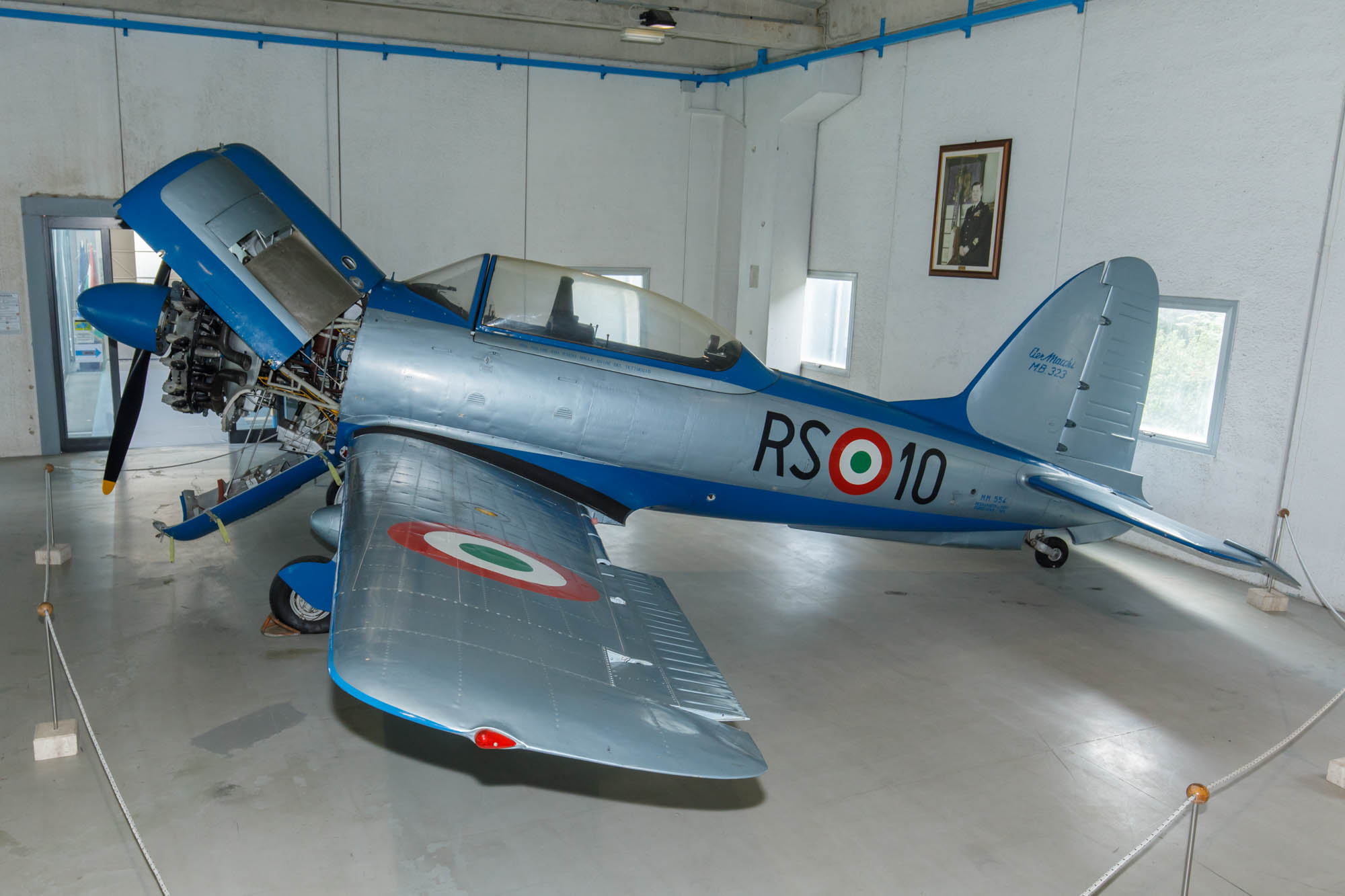 |
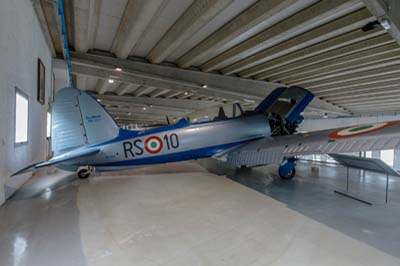 |
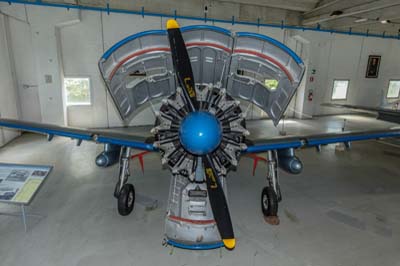 |
Aermacchi MB.323 (MM554 'RS-10'). This is the only prototype of the all-metal trainer which was constructed in 1952. It was initially flight tested at Guidonia and evaluated against the Fiat G.49. The project was finally cancelled in favour of the T-6 Texan. In the 1970s it was on display at the Palazzo della Vela in Turin. It was had been on display up to 2001 before it was removed for restoration, returning in 2009. By June 2023 it had been removed from display, but had returned by May 2024.
As photographed in; 1983 and 1988. |
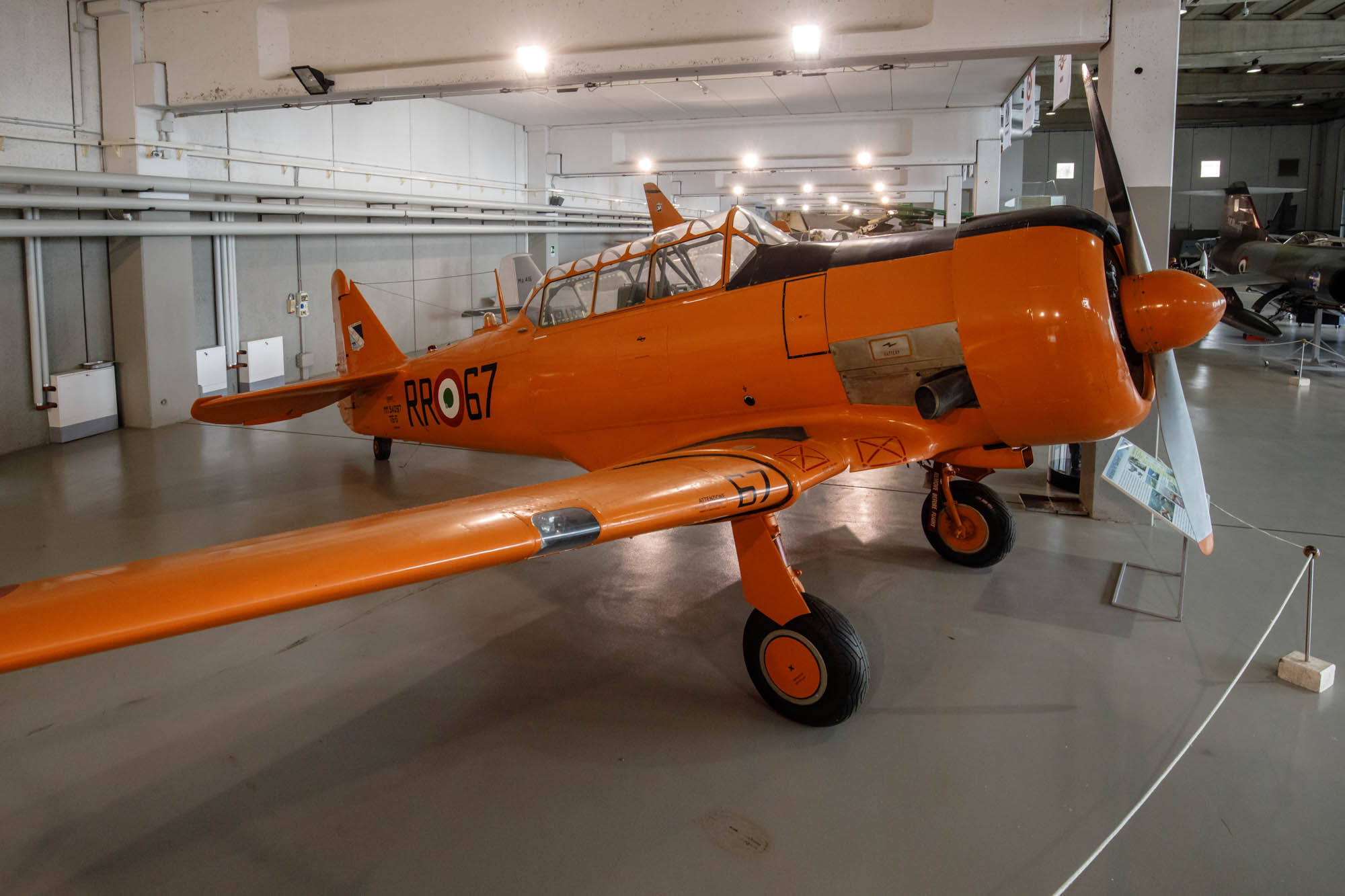 |
North American T-6G Texan (MM54097 'RR-67'). The AMI took delivery of the T-6 under the MDAP agreement to enable their pilot training to meet the new NATO standards. Deliveries ran from 1949 to 1958 (T-6C, AT-6D, T-6G and T-6H) and totalled over 200, most training units operated the aircraft. The T-6Cs and T-6Ds were eventually converted to T-6G standard and they remained in service until the end 1970s. The example on display was transferred to the museum in 1974 following its retirement as a liaison aircraft with the 2º Reparto Volo Regionale at nearby Guidonia and in whose colours it is displayed. It was restored by GAVS Vicenza from 2001 to 2002.
As photographed in; 1983 and 1996. |
| SIAI-Marchetti (Aermacchi) SF.260AM (MM54436 '70-36'). This military variant of pilot training aircraft was designed by Stelio Frati in the 1960s, it is fully aerobatic. In 1976 the AMI bought 45 examples for basic flying training duties. The final flight was made on September 19, 2009 by 70° Stormo at Latina the 'AM' version having logged 235,500 flight hours was superseded by the SF.260EA. The example on display was one of the last four to fly and arrived at the museum in Decmber 2011. |
| The Age of the Jet (home produced and foreign imports) |
Italian aircraft designers Caproni, were amongst the first to move into the age of jet propulsion. The Caproni Campini CC.1 was one of the World's first jet aircraft, flying for the first time in August 1940. It is really a hybrid, using a traditional piston engine, combined with a compressor, combustion chambers and exhaust system, the power coming from an afterburner. On display is a CC.1 (MM488). Another example which was used for static testing only and is only a fuselage, can be found in the National Science and Technical Museum, in Milan.
As photographed in; 1983 and 1990. |
| de Havilland DH.113 Vampire NF.54 (MM6152). From 1950 the AMI took delivery of a number of Vampires, prior to a producing their own (150 in total) by Fiat and Macchi. |
With the lack of success of Italian designed aircraft, the AMI looked further a field for its jet fighters. The F-84G Thunderjet first flew in 1946 and eventually 4,400 were built and used throughout NATO. From May 1952 the AMI took delivery of 254 F-84Gs, assigning them to 5º, 6º and 51º Stormo. Two display teams, the 'Getti Tonanti' in 1953 and the 'Tigre Bianche' in 1956, flew the type.
The F-84Gs were replaced by the 'F' and 'RF' versions from 1956. The F-84F Thunderstreak was an F-84G, but with a swept wing and over 2,700 were built, mostly for NATO countries. The AMI took delivery of 194 F-84Gs, from 1956. They were very popular aircraft, due to their impressive performance and handling. Six of these aircraft were also used by the 'Getti Tonanti' and 'Diavoli Rossi' display teams. They were finally replaced by the F-104S Starfighter as were the F-86s. A reconnaissance version, the RF-84F Thunderflash, was also used by the AMI. |
By August 2009 the 1950s jets had returned to Skema Hall 4 following restoration; North American F-86K Sabre (MM55-4868 '51-62'), North American F-86E Sabre Mk.4 (MM19792 '13-1'), F-84F Thunderstreak (MM53-6892 '36-38') and Republic F-84G Thunderjet (MM111049 '51-18'). As photographed in 1983.
The US built collection of 1950s jets operated by the AMI on display at various times included;
Republic F-84G Thunderjet (MM111049 '51-18') returned from a years restoration by 51º Stormo at Istrana in February 2009.
Republic F-84F Thunderstreak (MM53-6892 '36-38') on display for a number of years but had gone by November 2005 and returned by August 2009.
Canadair CL.13 Mk.4 (F-86E) Sabre (MM19792 '13-1') was transferred to Vicenza in October 2004 for restoration and returned by August 2009.
North American F-86K Sabre (MM55-4868 '51-62') on display for a number of years but had gone by November 2005 and returned by August 2009.
|
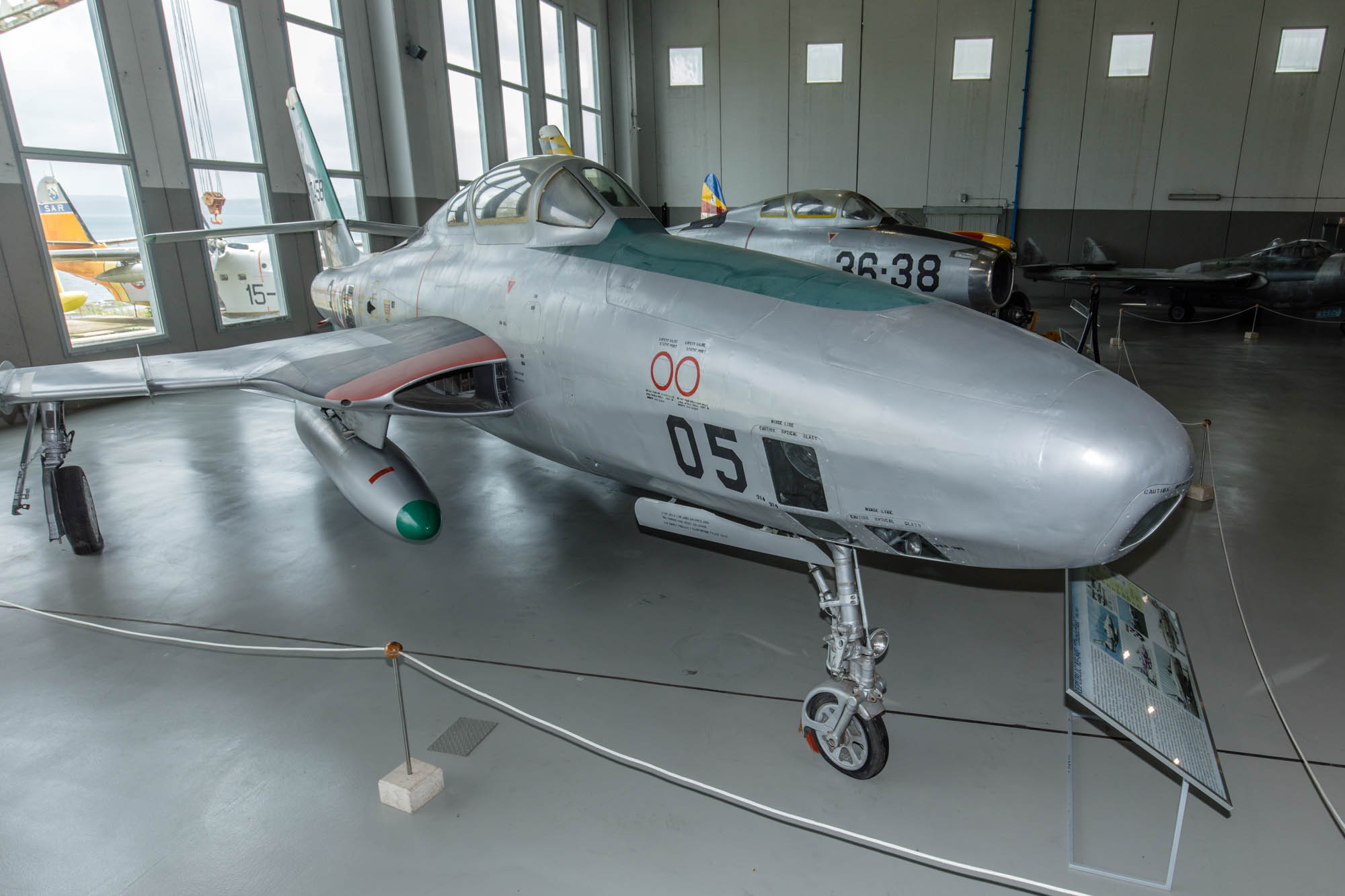 |
| Republic RF-84F Thunderflash (MM27458 '3-05') on display for a number of years but had gone by March 2008 for restoration by 156º Gruppo, 36º Stormo at Gioia del Colle and returned by July 2014. |
| Lockheed RT-33A Shooting Star (MM53-5594 '9-35'). The T-33A was based on the single seat P-80, first flying in 1948. The AMI received 60 T-33As from 1952 and 14 single-seat RT-33As. The aircraft on display is a RT-33A and is painted in a high visibility scheme dating back to its days with 9º Stormo (9 Wing), 609º Gruppo (609 Squadron) when employed on target towing duties. As photographed in 1990. |
| Republic
F-84F Thunderstreak (MM53-6892 '36-38') on display for a number of years but had gone by November 2005 and returned in March 2009, following restoration by 936º GEA in the authentic colours of 156º Gruppo, 36º Stormo from Gioia del Colle. |
| Republic F-84G Thunderjet (MM111049 '51-18' now painted as MM116746 '51-29') This aircraft was originally stored at Capodichino airport, Naples for many years following a crash, before being restored by 51º Stormo. It was painted in the special colours applied for the 1956 Fiumicino Air Show and was on display as such till February 2008 before returning from restoration in February 2009 in a different special scheme and inscribed on the nose 'Tigri Bianche'. |
| Canadair CL.13 Mk.4 (F-86E) Sabre (MM19792 '13-1') The North American F-86 first flew in 1947. Over 1,800 were built by Canadair under licence as the CL.13. 179 surplus RCAF CL.13s were transferred to the AMI in 1955. The example at the museum was transferred to Vicenza in October 2004 for restoration and returned by August 2009. |
| North American F-86K Sabre (MM55-4868 '51-62'). Derived from the F-86E the F-86K was built under licence by Fiat in Turin and first flew in May 1955. Eventually 221 were built in Italy. The F-86K on display was one of a batch received from France in 1962 to supplement the Italian built aircraft. It served with the 23º Gruppo, 51º Stormo at Istrana-Treviso before it passed to the museum in 1971. |
| Ambrosini Aerfer Sagittario II 'Ram' (MM561). First flown in 1956 it was an unsuccessful protoype fighter which returned to the museum after some years away (last seen April 2002) by August 2009. As photographed in 1988. |
| Ambrosini Aerfer Ariete (MM569) another prototype fighter, which was based on the Aerfer Sagittario II 'Ram'. Built in 1958 it first flew in March of that year. With less than expected results the project was cancelled and no further examples were built. |
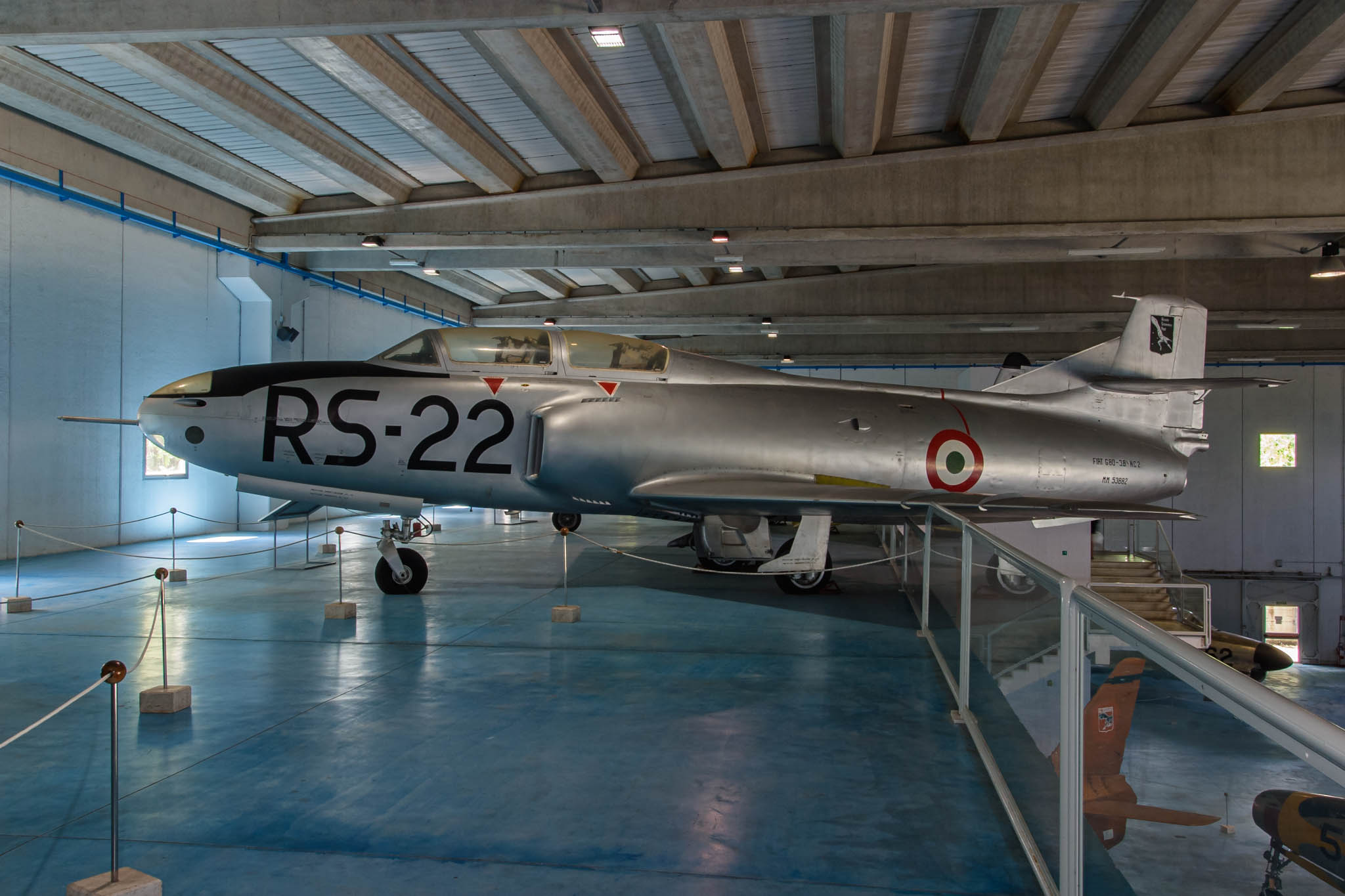 |
Fiat G-80 (MM53882 'RS-22') Fiat built, the G-80 which was designed by Gabrielli as an advanced two seat jet trainer. The first flight of one of the two initial prototypes, took place in December 1951. Later in May 1953 one of the two prototype G-82s, made its first flight. Another four G-82s were built and were transferred to the jet training school at Amendola. They eventually went on to the 'Reparto Sperimentale di Volo' (RSV) in 1957. The AMI were not too impressed by the performance of the G-80 and G-82 consequently and losing out to the MB-326 no further orders were forthcoming.
The Fiat G-80 on display is one of three pre-production aircraft that were built and tested by the R.S.V. at Pratica di Mare, in who's markings it still carries. MM53882 'RS-22' was on display outside here for many years, but following the opening of Skema hall it was restored and moved inside. Two of the G-82s (MM53886 'RS-19' and MM53888 'RS-21') were also stored outside the museum from it's earliest days until the mid 1990s when they returned to Pratica di Mare where they are now held in open store. |
| Aermacchi MB-326E (MM54389 '68') Designed by Bazzocchi at Macchi, the first of two prototype (MM571 and MM572) MB-326s first flew on December 10, 1957. It eventually won the competition with the Fiat G.80 to be accepted by the AMI. An initial order of 15 pre-production aircraft was followed by an order for 100 more in 1960. It entered service on January 15, 1962, replacing T-6 Texan, for primary jet training with 214º Gruppo flying school at Lecce-Galatina which was renamed as "Scuola Volo Basico Iniziale Aviogetti" (see badge on tail) at the same time. It was powered by a Rolls-Royce Viper engine. An additional twelve MB-326Es were ordered later, which included the aircraft on display. In 1982, after 20 years and more than 400.000 flying hours with the MB-326 was replaced by the MB339A. |
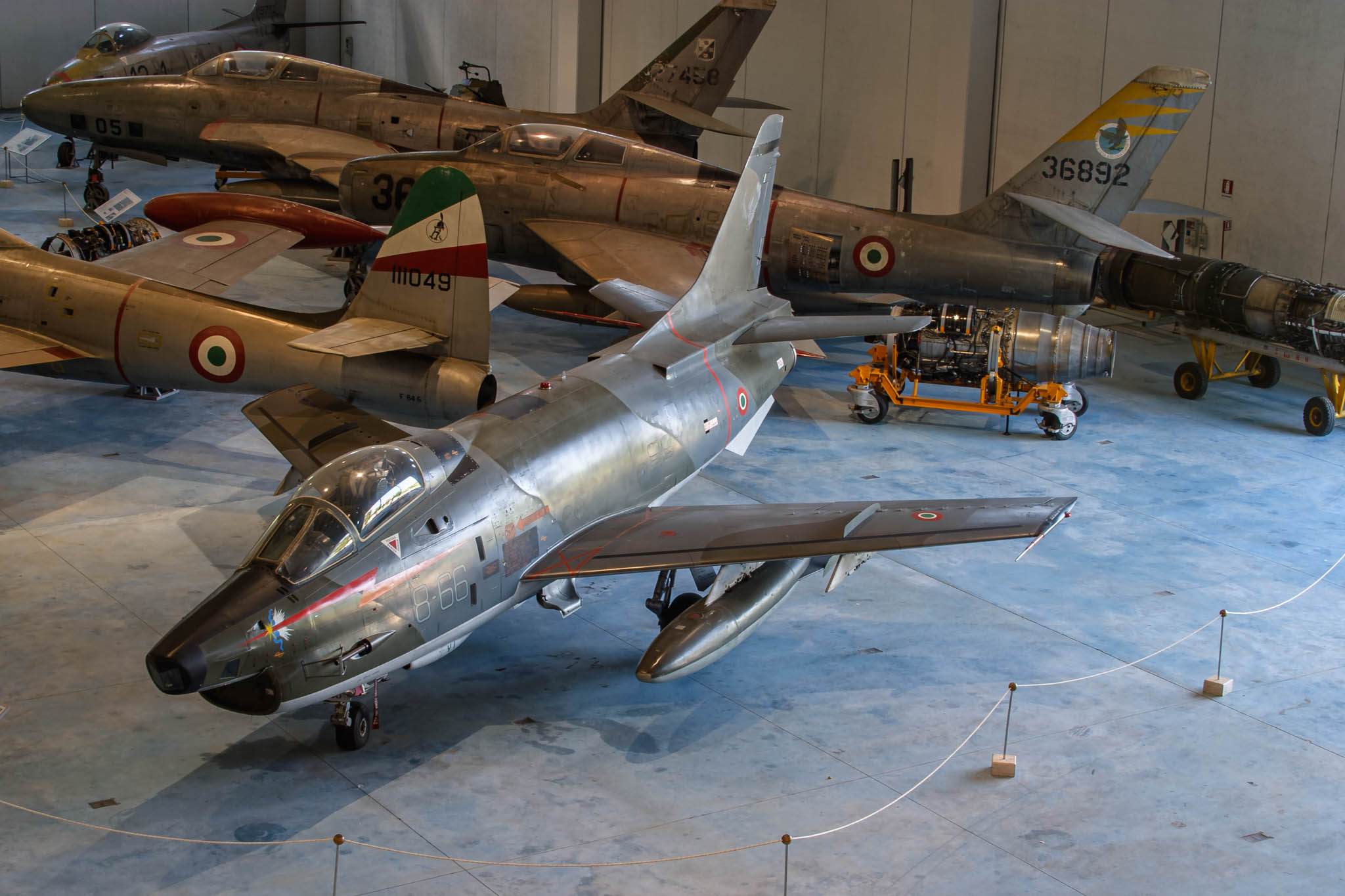 |
Inspired by the F-86 the Fiat G-91 was designed from 1953 for a NATO competition by Fiat Aviazione (later Aeritalia) which it eventually won. Built only in Germany and Italy, it first flew in 1956, entering service with the AMI in 1958. The G-91R was a reconnaissance version of the light fighter bomber, from which the G-91Y variant was developed, making its first flight on December 26,1966. Named 'Yankee' due to the shape of it's air intake, the G-91Y was the first G-91 to have an afterburner. Carrying a heavier payload and increased armament by means of two 30mm guns, it was less manoeuvrable than the G-91R. 65 'Yankee's were built under license by Aeritalia and delivered to 8º Stormo and 32º Stormo. They were eventually withdrawn from 1994 with the arrival of the AMX.
Above: Fiat Aviazione (later Aeritalia) G-91Y (MM6959 '8-66') is painted in 8º Stormo, 101º Gruppo markings from when it was based at Cervia. |
| Two-seat Fiat Aviazione (later Aeritalia) G-91T (MM6344 'SA-47' previously exhibited as '32-44'). |
| Fiat Aviazione (later Aeritalia) G-91PAN (MM6250 '9') painted as display team Frecce Tricolori '9'. |
| Aermacchi MB-339A/PAN (MM54485 '0') painted as display team Frecce Tricolori '0', it arrived at the Museum on December 4, 2012. Deliveries of the MB-339A began in 1979. |
Fiat Aviazione (later Aeritalia) G-91R (MM6280 '2-33') which has the panels cut away on the port side only.
Other G-91s have passed through the museum (including MM6405 '2-05' first seen August 1996 but had gone by March 2008) over the years. The G-91 collection had moved into its new home, an annex to Hall 4 'Skema' by August 2009. The G-91 is obviously a well loved aircraft at the museum. |
Left to right: Lockheed F-104G Starfighter (MM6501 '3-11') The first F-104A Starfighter flew in 1954. Production of the multi-role, all-weather strike fighter was started in many of the countries which adopted this unique aircraft, apart from Fiat/Aeritalia, including Fokker in Holland, Messerschmitt in Germany and SABCA in Belgium. As photographed in 1994.
The initial batch of 12 two-seat TF-104G Starfighter's were manufactured by Lockheed and assembled by FIAT from 1965. The F-104G had a maximum speed of 1,328 m.p.h. at 35,000 feet and could climb to 90,000 feet. The first F/RF/TF-104G Starfighters entered service with the AMI in 1963 to replace the F-86 and F-84s. FIAT eventually manufactured 164 F-104G, 119 RF-104G and 245 F-104S 40 of which were exported to Turkey. The S for 'Sparrow' variant was an improved F-104G capable of fulfilling the air-to-ground attacking role utilising the R21G/H ground mapping contour following radar and deliveries were completed in 1979. Some aircraft were later upgraded to F-104S ASA standard to carry the Apside and AIM-9L air to air missile from 1988. The F-104Gs remained in service until 1983 and the last AMI Starfighter was not withdrawn until 2004. |
 |
| The Panavia Tornado F.3 ADV (MM7210 '36-12', formally with the Royal Air Force as ZE836) which replaced another Tornado (MM7001 'RS-01') which had been here for well over ten years when last noted in November 2005. |
| Alenia/Aermacchi/Embraer AMX (MM7125 'RS-11') An Italian-Brazilian joint venture the AMX was designed for the; ground-attack, close air support and the reconnaissance role. In Italy the AMX was introduced to replace the G-91. The 1981 agreement between the Italian and Brazilian Governments was for 187 and 100 aircraft respectively, all components were built either in Italy or Brazil. The prototype first flew in May 1984 and in 1988 the first production aircraft flew by 1989 51° Stormo, 103° Gruppo started receiving its first AMX. The two-seat AMX-T was developed from 1986 and it first flew in 1990. |
| Communications and surveillance aircraft with the AMI |
| The Fieseler Fi 156 Storch 'Stork' (MM12822 '20' and registered G-FIST). Designed in 1935 the Storch was able to fulfil a variety of roles due to its incredible Short-Take-Off and Landing (STOL) capabilities. 2,549 examples were built in Germany, Czechoslovakia and France. This remarkable aircraft could take off in 50 meters and land in under 30 meters. 24 Fi 156s were operated by the AMI during World War Two. The example on display was flown by Furlo Lauro who was awarded the Gold Medal for his exploits in rescuing downed pilots and carrying personnel across the Italian front during 1944 and 1945. |
| Piaggio P.166ML1 (MM61933 '53-34'). The P.166s design followed on from the P.136 amphibian of which several were to be seen at the museum until the mid 1990s when they were put into store at Guidonia. The first prototype P.166 took to the air in 1957. The P.166 was used for multi-engine aircraft pilot training at Latina with Scuola Volo Basico Avanzato Elica (SVBAE) and also for transport, liaison and Search and Rescue (SAR). 303º Gruppo at Guidonia utilised the P.166M/APH for aerial surveys until its retirement in 1997. Piaggio P.166ML-1s MM61874 and MM61890 were here in 1986 but had gone by 1993. |
Douglas C-47A (MM61776 '14-45'). On display at the museum by 2004 the C-47 was formally with 14º Stormo and subsequently been in open store at Guidonia for decades, along with some other less fortunate examples before it was rescued, repainted and put on display.
40 DC-3/C-47s were supplied to the Italian Air Force from the 1950. They were used for multi-engine training, VIP transports and numerous other duties. |
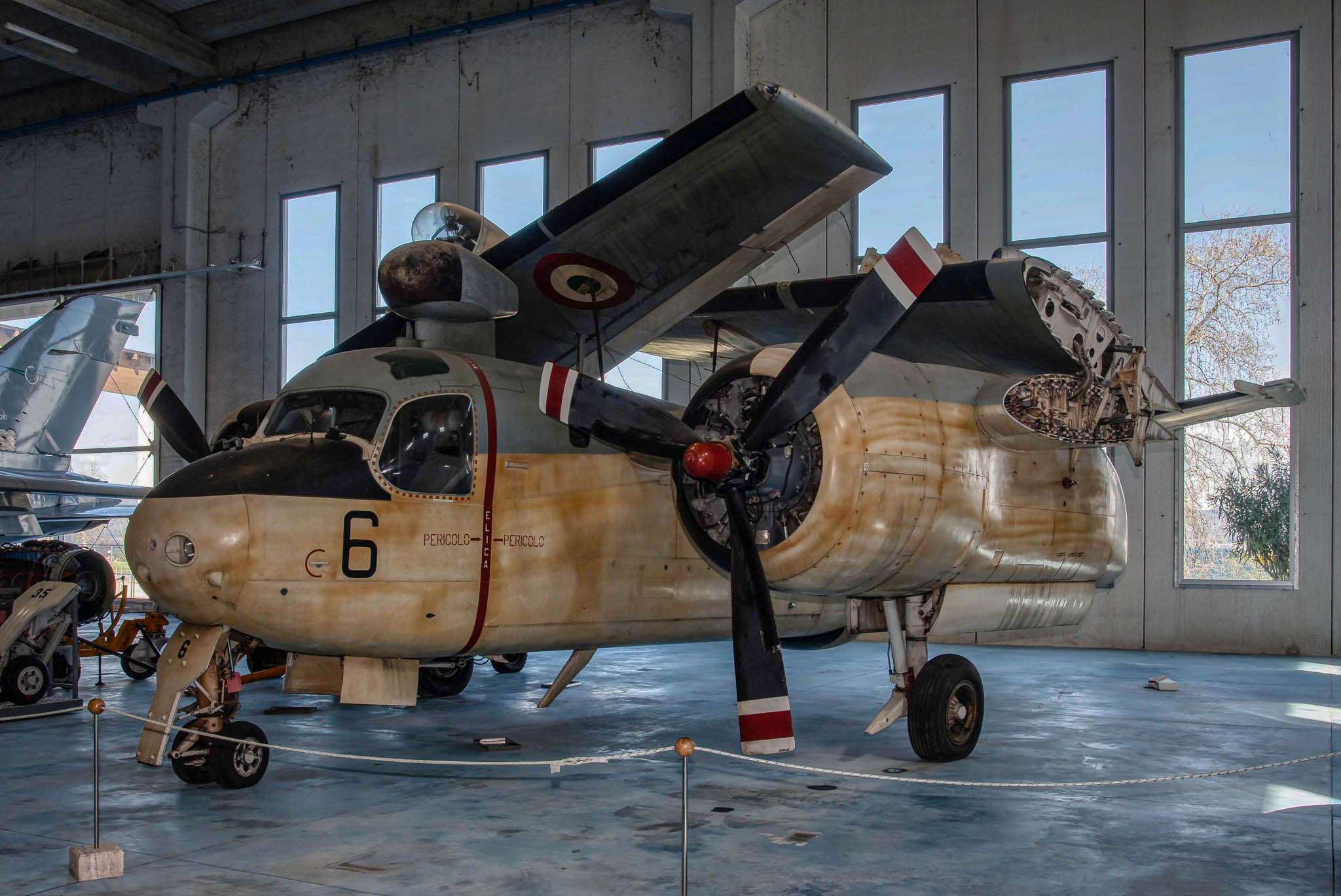 |
Grumman S-2F Tracker (MM136556 '41-6'). The prototype Tracker (XS-2F-1) first flew in 1952 and entered service two years later. The aircraft was employed in Anti-Submarine Warfare (ASW) duties by a number of countries. Deliveries of the S-2F began in 1957 to the AMI under the United States Military Defense Aid Program (MDAP). The S-2F-1 was later designated the S-2A, although the AMI continued to use the original designation. The first six were delivered to Capodichino in 1957, followed by another 14 in 1959 and a further 10 in 1961 all to Brindisi. A final delivery of 15 aircraft followed in 1964. The aircraft were later operated by two squadrons (30º and 41º Stormo) based at Sigonella in Sicily remained in service until its gradual withdrawal in the 1970s when replaced by the Bréguet Atlantic. The last AMI Tracker flew on August 31, 1978.
The Museo Storico also has on display the nose of another Tracker (MM148295 '41-35') which was part of a batch that did not have the wing-folding mechanism. It was first seen here in 2004 more than 20 years after the complete example was put on display, which was the first aircraft delivered to the AMI. As photographed in 1996. |
The Piaggio Douglas PD-808GE (MM61961) The PD-808 first flew in August 1964 and only 27 were built. The example on display last flew on May 17, 2003, when with 71º Gruppo at Pratica di Mare and employed in the ECM role.
It was first seen in August 2004 in Badoni hall, by August 2006 it had placed outside the hangar and by March 2008 it had been moved towards the car park to make room to the extension to Skema hall. |
| Left to right: Agusta Bell AB-47G (MM80113 '12') The first Agusta Bell AB-47G flew on May 22, 1954 and were employed in the training role initially with the Centro Elicotteri and later the Scuola Volo Elicotteri (SVE). The later J models remained in service until the 1970s. |
| Left to right: Agusta Bell AB-47J (MM80187 'SE-38') which was operated by the Scuola Volo Ellcotteri. |
| Left to right: Agusta Bell AB-204B (MM80357 'RM-112') Based on the Bell UH-1, it is a utility helicopter including Search and Rescue (SAR) and first appeared here in 2009. |
| Agusta-Sikorsky SH-3D/TS (MM80973) It has been especially equipped for VIP transport with the 31° Stormo and was better known as 'the Pope's Helicopter' as it was in service as such for 35 years up to it's retirement following it's final flight from Ciampino to Vigna di Valle on October 17, 2012. |
| Libratore Bonomi BS.17 'Allievo Cantù' glider was built from 1930 and designed for training students to fly, around 50 were delivered. It is made out of wooden battens and plywood with canvas lined wings. |
| Aeronautica Lombarda CVV.6 (MM100028) On display in Hall 4 'Skema' it had been flying in Turin in 2006 in all white scheme. It is inscribed '24 September 1964 Primato Internazionale Di Quota'. |
Some of the many attractive badges carried by some of the aircraft on display.
Left to right: Piaggio P.166ML1 (MM61933 '53-34'), Macchi MC.200 'Saetta' (MM5311 '369-1'), Fiat CR.42 'Falco' (as 'MM5643 '162-6') and Fiat CR.32 (as C.1-328 '3-6' of the Spanish Air Force). |
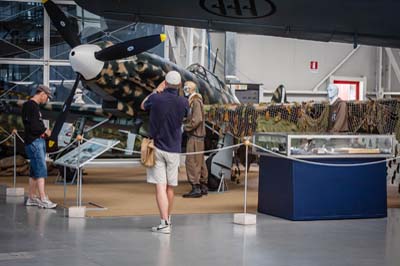 |
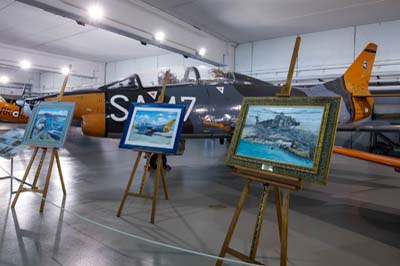 |
Where have the aircraft gone, I can't see them anymore? |
Where have the aircraft gone, I can't see them anymore?
Over the last three decades I have seen many improvements to the museum I love, a new hall has been built and many aircraft that were deteriorating outside are now protected inside. The original hangars including the modern Hall 4 'Skema' were very dark, they now have glass frontages (See image on right), making them much lighter and better for photography. The floors have more recently been resurfaced.
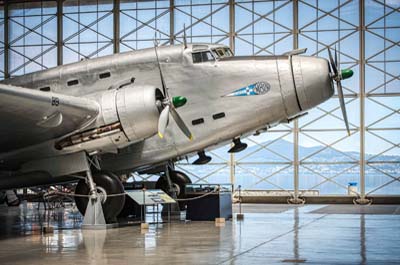
This is a photography based website and so I must reluctantly say that not everything at the museum has improved and is as I would have wished. Many of the exhibits are now surrounded by all sorts of paraphernalia, from display cabinets of model aircraft and medals etc., to engines, information boards, full size manikins adorned with pilots uniforms and an enormous amount of paintings of varying quality. It is becoming impossible to see the aircraft anymore! (See image on left). This clutter as grown considerably in the last few years. I do appreciate that many people like to see these kinds of exhibits, for the photographer it has become virtually impossible to get clear shots of many of the aircraft.
I hope I have given a good idea of what you should expect to see. Over the many years of visiting the museum I have personally seen well over 100 different airframes here, but never more than 70 at any one time. Currently there are around 60 aircraft on show. The collection is constantly changing as airframes are moved away for restoration and others are taken out of store. When I next get the chance to visit, I will be hoping to see some of my old 'friends', that are not currently displayed, having returned to the museum after a period of restoration. Restoration is important here but it is very time consuming and comes with a cost.
Restoration
A number of airframes were put on display as they were recovered. However, with help from volunteer groups, some aircraft have 'disappeared' only to return spruced up, following extensive restoration. 'Gruppo Amici Velivoli Storici' (GAVS). GAVS are a non-profit making aircraft restoration society first established in 1983 in Turin. They have centres for restoration in Turin, Vicenza, Rome, Genoa and Lombardy. They have spent 6,000 voluntary hours over the last three years, restoring aircraft for various museums. GAVS publish for it's members, a magazine 'Ali Antiche', which is dedicated to aircraft restoration and preservation. They have done much of the valuable and painstaking restoration for the museum, notably over the years, the Ansaldo SVA-5 in 1988 and the G-55 'Centauro' in 1995. The Rome section of GAVS recently restored the Spanish built Fiat CR.32 (Hispano HA 132L) in Spanish civil war colours. F-86E Sabre (MM19792 code '13-1') had moved to GAVS at Vicenza by October 2004 for restoration returning by August 2009. The 3º RTA (10º RMV) at Lecce, have also done valuable work for the museum, including completing the modification of the Fiat G-59 to a G-55 in 1997. The more recent restoration of the Macchi M.67 was done in part by Associazione Aeronautical Restoration of Varese.
I have been visiting this museum most years for the last 30 years, since marrying my long suffering Italian wife in 1979. Right from the outset in the late seventies, construction work has been carried out on the site, but at a very slow pace. I have seen many changes to the buildings and to the aircraft themselves. Originally you had to gain entrance through main gate of the adjoining military camp. Then you had to leave your passport with them and were requested to make a 'donation' to the soldiers on guard. In those early days a number of aircraft were 'stored' outside by workshops on the military camp. As the museum grew, more and more aircraft were left outside, at the mercy of the elements, either just outside the main buildings or further towards the new car park. Following the construction of Skema hall nearly all the exhibits are undercover and protected from the elements.
There were prolonged periods in the nineties, when Hall 4 was housing the 1950s jets, but was not open to the public. In 1998 the Italian Air Force held their 75th Anniversary air show at Pratica di Mare. For this event a number of museum aircraft were taken from Vigna di Valle for static display. These included the; Fiat C.29, G.5bis, G.55, G.80, Macchi C.200, C.202, C.205, SM.79 and the Fi-156. This was a rare opportunity to see these aircraft out in the sun.
The museum was completely closed to the public at the end of the nineties, until it was reopened on August 5, 1999. Later Hall 3 'Badoni' was closed throughout 2001 and into 2002 while it was being refurbished. Today all four halls are fully open and connected by way of adjoining doors and more recently walkways. It all looks very impressive, with around 60 aircraft on display, beside the clear waters of Lake Bracciano. So why not make plans to visit?
How do you get to the Museo Storico?
Cheap flights to Rome mean that it is now a great long weekend vacation. Why not treat the wife to some ancient Roman architecture and Italian restaurants, but more importantly visit this wonderful museum, you won't be disappointed? Don't forget that the museum, which is free, is closed on Mondays, otherwise it is open all year round.
Opening times:
(1st June – 30th September) 09:30 – 17:30
(1st October – 31st May) 09:30 – 16:30.
CLOSED on Mondays, New Year’s Day, Easter and Christmas.
The Museum was closed to the public for renovation (MUSAM 2023) from October 2021 and is not due to reopen until 2023.
Note: Please check out the museum's website to confirm opening times. Over the years there has been extended periods where the museum has been part or fully closed. |

|
 |


